Business accounting Assignment
VerifiedAdded on 2021/12/17
|18
|4456
|68
AI Summary
Contribute Materials
Your contribution can guide someone’s learning journey. Share your
documents today.
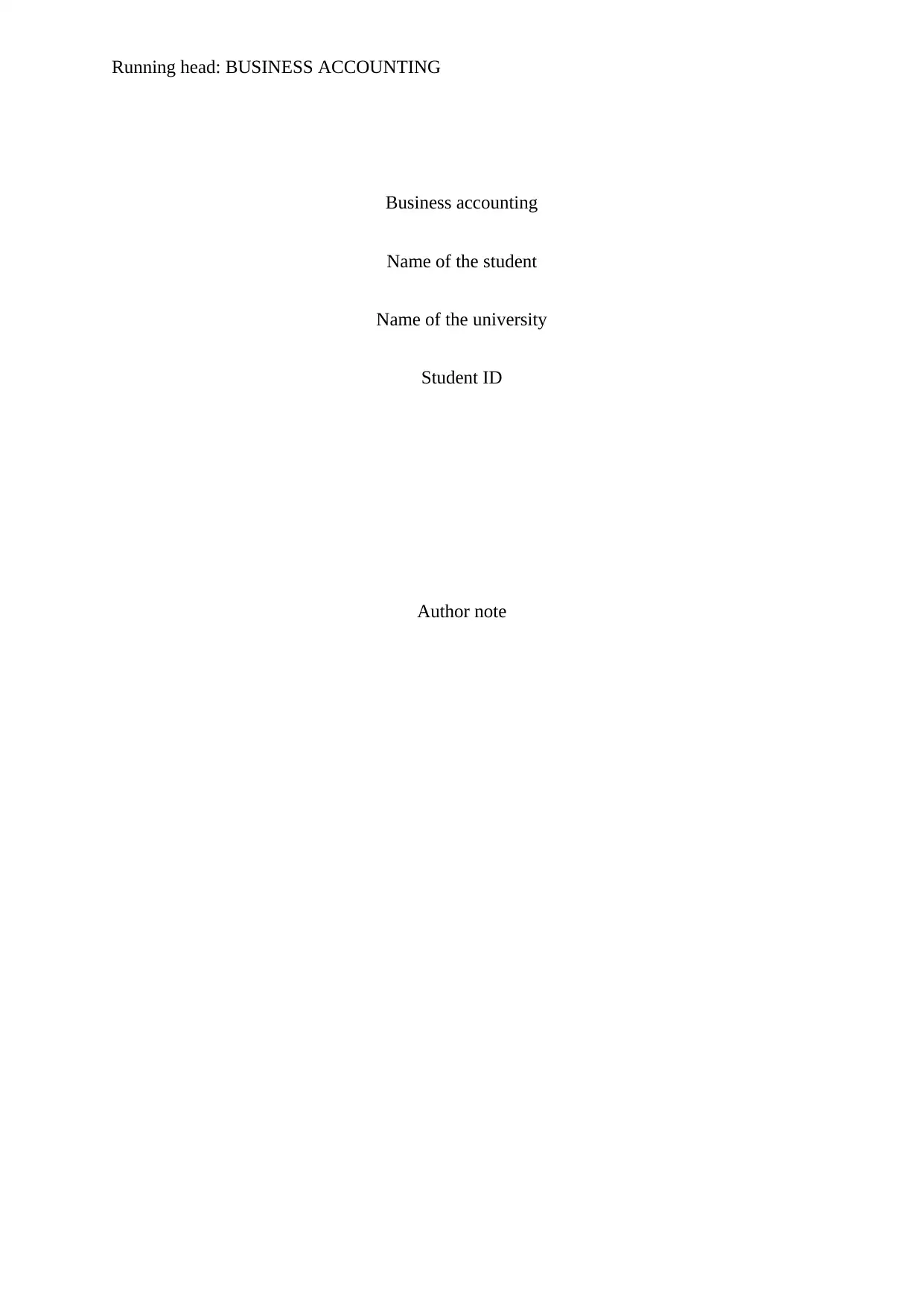
Running head: BUSINESS ACCOUNTING
Business accounting
Name of the student
Name of the university
Student ID
Author note
Business accounting
Name of the student
Name of the university
Student ID
Author note
Secure Best Marks with AI Grader
Need help grading? Try our AI Grader for instant feedback on your assignments.
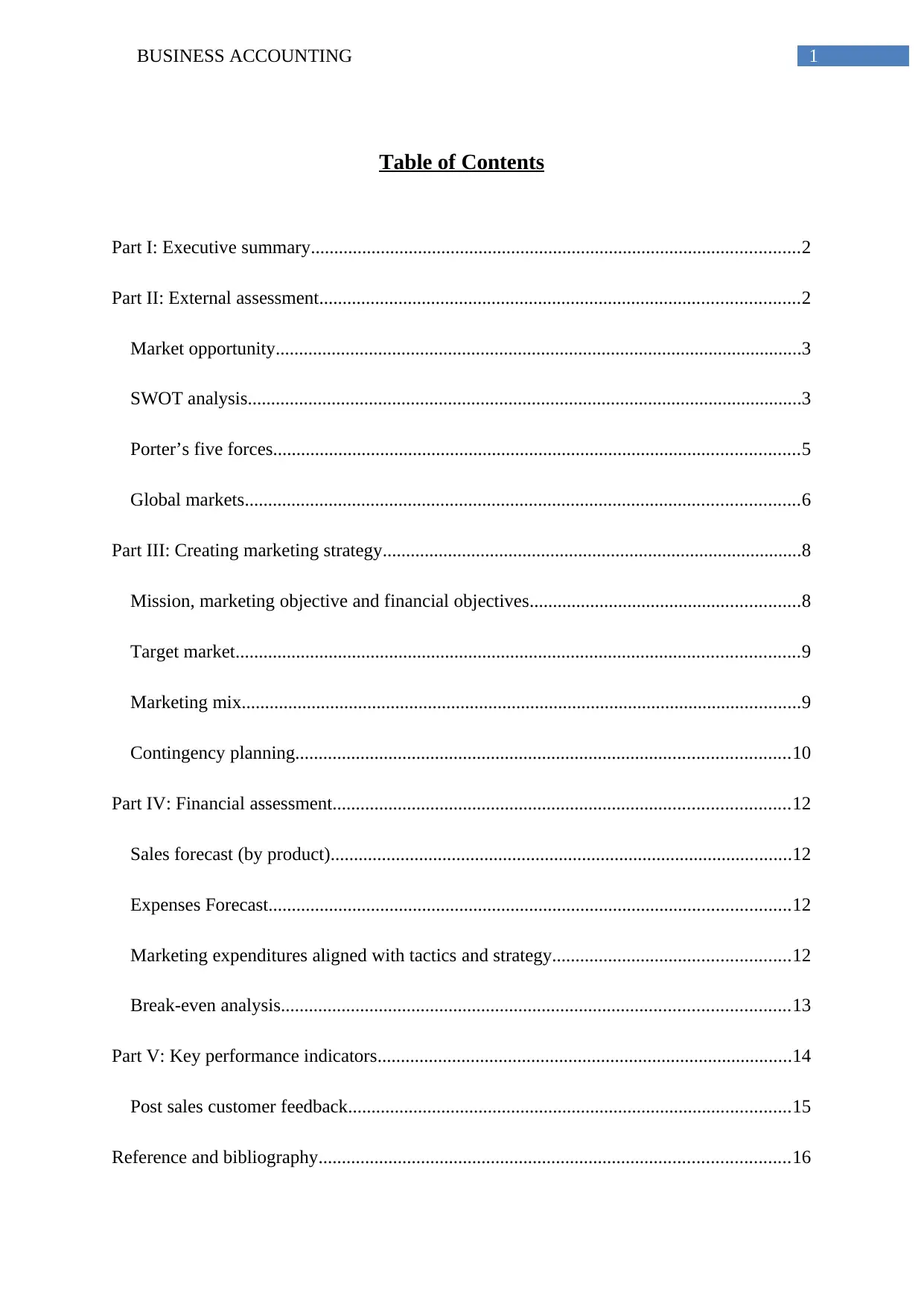
1BUSINESS ACCOUNTING
Table of Contents
Part I: Executive summary.........................................................................................................2
Part II: External assessment.......................................................................................................2
Market opportunity.................................................................................................................3
SWOT analysis.......................................................................................................................3
Porter’s five forces.................................................................................................................5
Global markets.......................................................................................................................6
Part III: Creating marketing strategy..........................................................................................8
Mission, marketing objective and financial objectives..........................................................8
Target market.........................................................................................................................9
Marketing mix........................................................................................................................9
Contingency planning..........................................................................................................10
Part IV: Financial assessment..................................................................................................12
Sales forecast (by product)...................................................................................................12
Expenses Forecast................................................................................................................12
Marketing expenditures aligned with tactics and strategy...................................................12
Break-even analysis.............................................................................................................13
Part V: Key performance indicators.........................................................................................14
Post sales customer feedback...............................................................................................15
Reference and bibliography.....................................................................................................16
Table of Contents
Part I: Executive summary.........................................................................................................2
Part II: External assessment.......................................................................................................2
Market opportunity.................................................................................................................3
SWOT analysis.......................................................................................................................3
Porter’s five forces.................................................................................................................5
Global markets.......................................................................................................................6
Part III: Creating marketing strategy..........................................................................................8
Mission, marketing objective and financial objectives..........................................................8
Target market.........................................................................................................................9
Marketing mix........................................................................................................................9
Contingency planning..........................................................................................................10
Part IV: Financial assessment..................................................................................................12
Sales forecast (by product)...................................................................................................12
Expenses Forecast................................................................................................................12
Marketing expenditures aligned with tactics and strategy...................................................12
Break-even analysis.............................................................................................................13
Part V: Key performance indicators.........................................................................................14
Post sales customer feedback...............................................................................................15
Reference and bibliography.....................................................................................................16
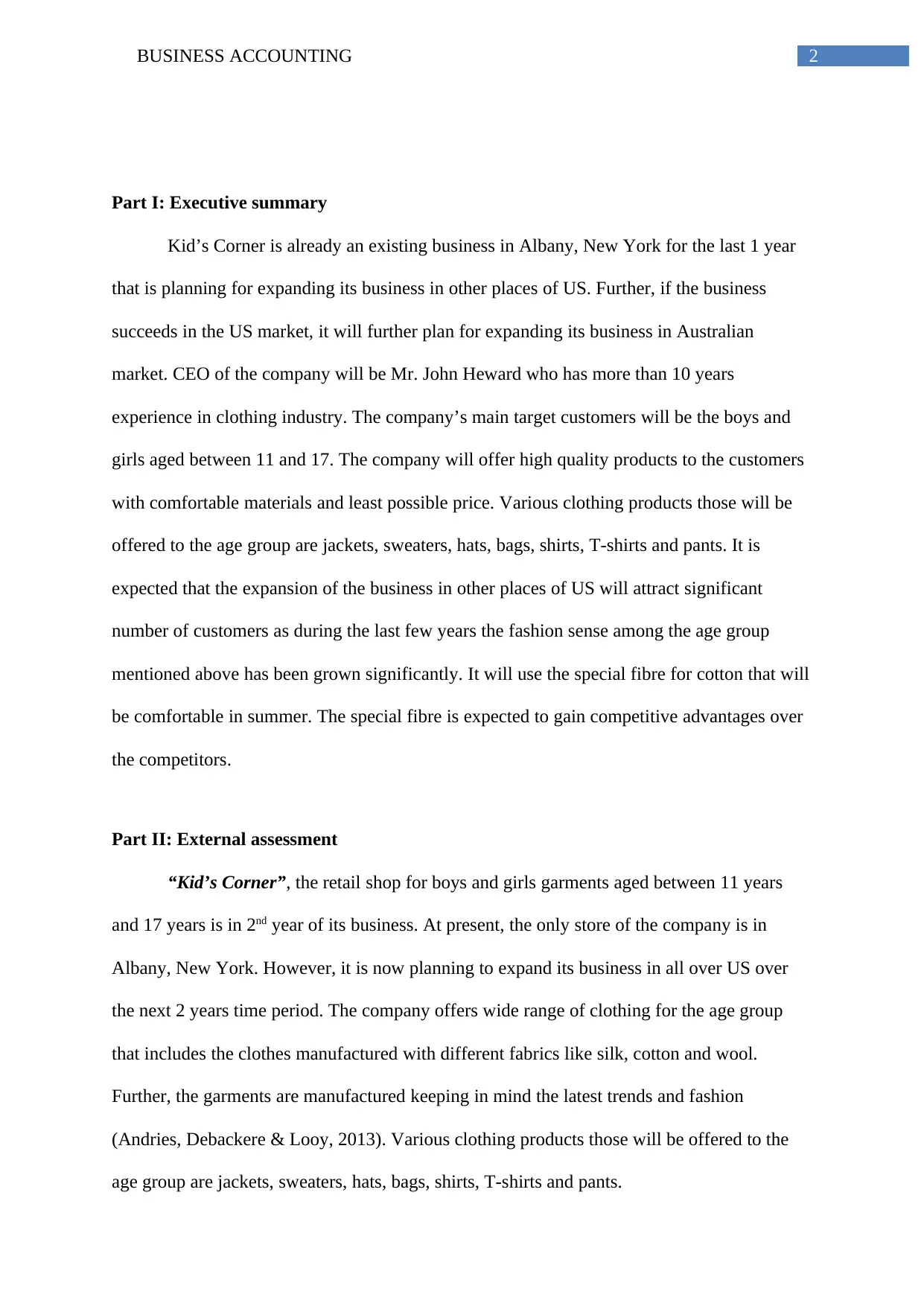
2BUSINESS ACCOUNTING
Part I: Executive summary
Kid’s Corner is already an existing business in Albany, New York for the last 1 year
that is planning for expanding its business in other places of US. Further, if the business
succeeds in the US market, it will further plan for expanding its business in Australian
market. CEO of the company will be Mr. John Heward who has more than 10 years
experience in clothing industry. The company’s main target customers will be the boys and
girls aged between 11 and 17. The company will offer high quality products to the customers
with comfortable materials and least possible price. Various clothing products those will be
offered to the age group are jackets, sweaters, hats, bags, shirts, T-shirts and pants. It is
expected that the expansion of the business in other places of US will attract significant
number of customers as during the last few years the fashion sense among the age group
mentioned above has been grown significantly. It will use the special fibre for cotton that will
be comfortable in summer. The special fibre is expected to gain competitive advantages over
the competitors.
Part II: External assessment
“Kid’s Corner”, the retail shop for boys and girls garments aged between 11 years
and 17 years is in 2nd year of its business. At present, the only store of the company is in
Albany, New York. However, it is now planning to expand its business in all over US over
the next 2 years time period. The company offers wide range of clothing for the age group
that includes the clothes manufactured with different fabrics like silk, cotton and wool.
Further, the garments are manufactured keeping in mind the latest trends and fashion
(Andries, Debackere & Looy, 2013). Various clothing products those will be offered to the
age group are jackets, sweaters, hats, bags, shirts, T-shirts and pants.
Part I: Executive summary
Kid’s Corner is already an existing business in Albany, New York for the last 1 year
that is planning for expanding its business in other places of US. Further, if the business
succeeds in the US market, it will further plan for expanding its business in Australian
market. CEO of the company will be Mr. John Heward who has more than 10 years
experience in clothing industry. The company’s main target customers will be the boys and
girls aged between 11 and 17. The company will offer high quality products to the customers
with comfortable materials and least possible price. Various clothing products those will be
offered to the age group are jackets, sweaters, hats, bags, shirts, T-shirts and pants. It is
expected that the expansion of the business in other places of US will attract significant
number of customers as during the last few years the fashion sense among the age group
mentioned above has been grown significantly. It will use the special fibre for cotton that will
be comfortable in summer. The special fibre is expected to gain competitive advantages over
the competitors.
Part II: External assessment
“Kid’s Corner”, the retail shop for boys and girls garments aged between 11 years
and 17 years is in 2nd year of its business. At present, the only store of the company is in
Albany, New York. However, it is now planning to expand its business in all over US over
the next 2 years time period. The company offers wide range of clothing for the age group
that includes the clothes manufactured with different fabrics like silk, cotton and wool.
Further, the garments are manufactured keeping in mind the latest trends and fashion
(Andries, Debackere & Looy, 2013). Various clothing products those will be offered to the
age group are jackets, sweaters, hats, bags, shirts, T-shirts and pants.
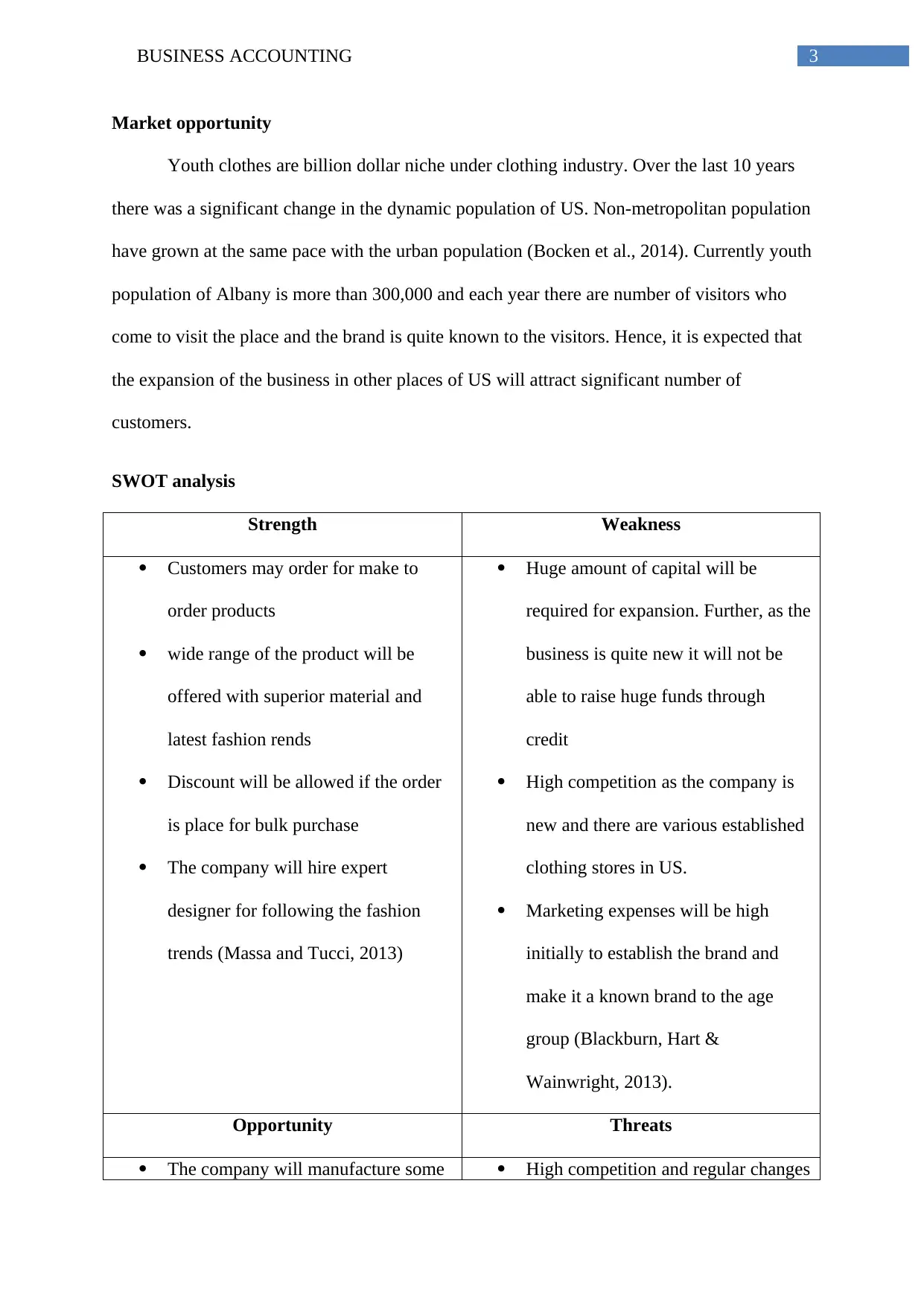
3BUSINESS ACCOUNTING
Market opportunity
Youth clothes are billion dollar niche under clothing industry. Over the last 10 years
there was a significant change in the dynamic population of US. Non-metropolitan population
have grown at the same pace with the urban population (Bocken et al., 2014). Currently youth
population of Albany is more than 300,000 and each year there are number of visitors who
come to visit the place and the brand is quite known to the visitors. Hence, it is expected that
the expansion of the business in other places of US will attract significant number of
customers.
SWOT analysis
Strength Weakness
Customers may order for make to
order products
wide range of the product will be
offered with superior material and
latest fashion rends
Discount will be allowed if the order
is place for bulk purchase
The company will hire expert
designer for following the fashion
trends (Massa and Tucci, 2013)
Huge amount of capital will be
required for expansion. Further, as the
business is quite new it will not be
able to raise huge funds through
credit
High competition as the company is
new and there are various established
clothing stores in US.
Marketing expenses will be high
initially to establish the brand and
make it a known brand to the age
group (Blackburn, Hart &
Wainwright, 2013).
Opportunity Threats
The company will manufacture some High competition and regular changes
Market opportunity
Youth clothes are billion dollar niche under clothing industry. Over the last 10 years
there was a significant change in the dynamic population of US. Non-metropolitan population
have grown at the same pace with the urban population (Bocken et al., 2014). Currently youth
population of Albany is more than 300,000 and each year there are number of visitors who
come to visit the place and the brand is quite known to the visitors. Hence, it is expected that
the expansion of the business in other places of US will attract significant number of
customers.
SWOT analysis
Strength Weakness
Customers may order for make to
order products
wide range of the product will be
offered with superior material and
latest fashion rends
Discount will be allowed if the order
is place for bulk purchase
The company will hire expert
designer for following the fashion
trends (Massa and Tucci, 2013)
Huge amount of capital will be
required for expansion. Further, as the
business is quite new it will not be
able to raise huge funds through
credit
High competition as the company is
new and there are various established
clothing stores in US.
Marketing expenses will be high
initially to establish the brand and
make it a known brand to the age
group (Blackburn, Hart &
Wainwright, 2013).
Opportunity Threats
The company will manufacture some High competition and regular changes
Secure Best Marks with AI Grader
Need help grading? Try our AI Grader for instant feedback on your assignments.
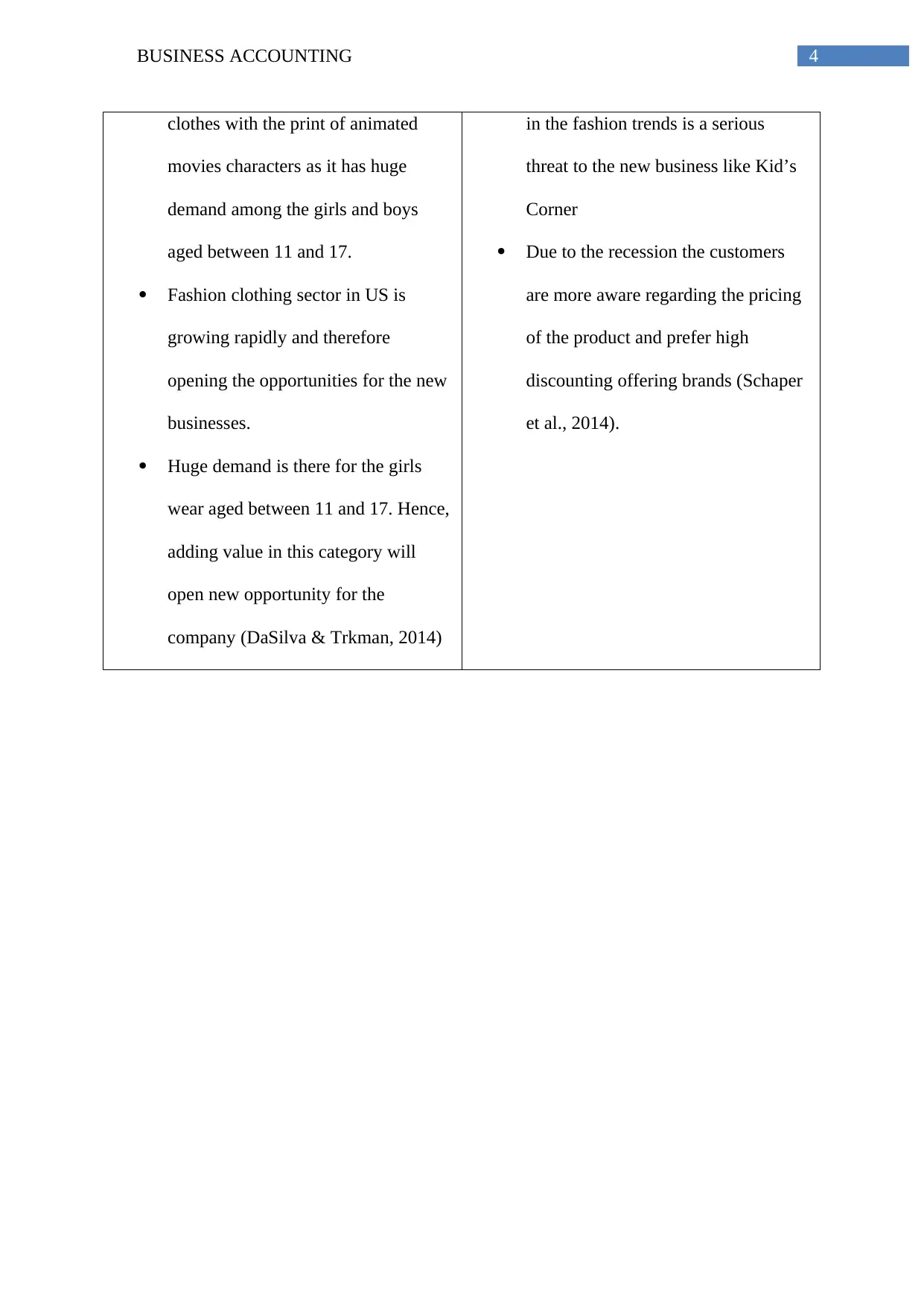
4BUSINESS ACCOUNTING
clothes with the print of animated
movies characters as it has huge
demand among the girls and boys
aged between 11 and 17.
Fashion clothing sector in US is
growing rapidly and therefore
opening the opportunities for the new
businesses.
Huge demand is there for the girls
wear aged between 11 and 17. Hence,
adding value in this category will
open new opportunity for the
company (DaSilva & Trkman, 2014)
in the fashion trends is a serious
threat to the new business like Kid’s
Corner
Due to the recession the customers
are more aware regarding the pricing
of the product and prefer high
discounting offering brands (Schaper
et al., 2014).
clothes with the print of animated
movies characters as it has huge
demand among the girls and boys
aged between 11 and 17.
Fashion clothing sector in US is
growing rapidly and therefore
opening the opportunities for the new
businesses.
Huge demand is there for the girls
wear aged between 11 and 17. Hence,
adding value in this category will
open new opportunity for the
company (DaSilva & Trkman, 2014)
in the fashion trends is a serious
threat to the new business like Kid’s
Corner
Due to the recession the customers
are more aware regarding the pricing
of the product and prefer high
discounting offering brands (Schaper
et al., 2014).
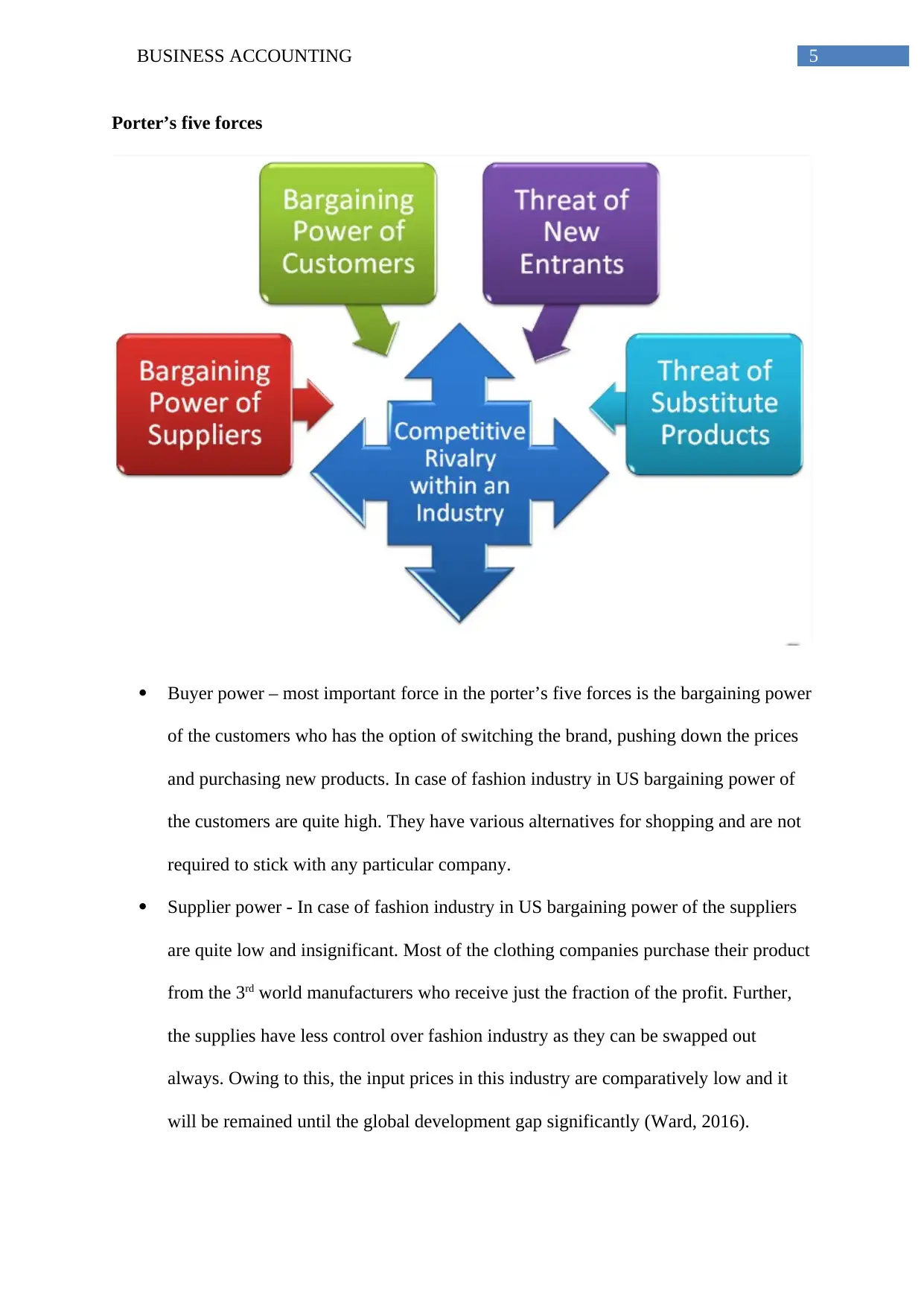
5BUSINESS ACCOUNTING
Porter’s five forces
Buyer power – most important force in the porter’s five forces is the bargaining power
of the customers who has the option of switching the brand, pushing down the prices
and purchasing new products. In case of fashion industry in US bargaining power of
the customers are quite high. They have various alternatives for shopping and are not
required to stick with any particular company.
Supplier power - In case of fashion industry in US bargaining power of the suppliers
are quite low and insignificant. Most of the clothing companies purchase their product
from the 3rd world manufacturers who receive just the fraction of the profit. Further,
the supplies have less control over fashion industry as they can be swapped out
always. Owing to this, the input prices in this industry are comparatively low and it
will be remained until the global development gap significantly (Ward, 2016).
Porter’s five forces
Buyer power – most important force in the porter’s five forces is the bargaining power
of the customers who has the option of switching the brand, pushing down the prices
and purchasing new products. In case of fashion industry in US bargaining power of
the customers are quite high. They have various alternatives for shopping and are not
required to stick with any particular company.
Supplier power - In case of fashion industry in US bargaining power of the suppliers
are quite low and insignificant. Most of the clothing companies purchase their product
from the 3rd world manufacturers who receive just the fraction of the profit. Further,
the supplies have less control over fashion industry as they can be swapped out
always. Owing to this, the input prices in this industry are comparatively low and it
will be remained until the global development gap significantly (Ward, 2016).
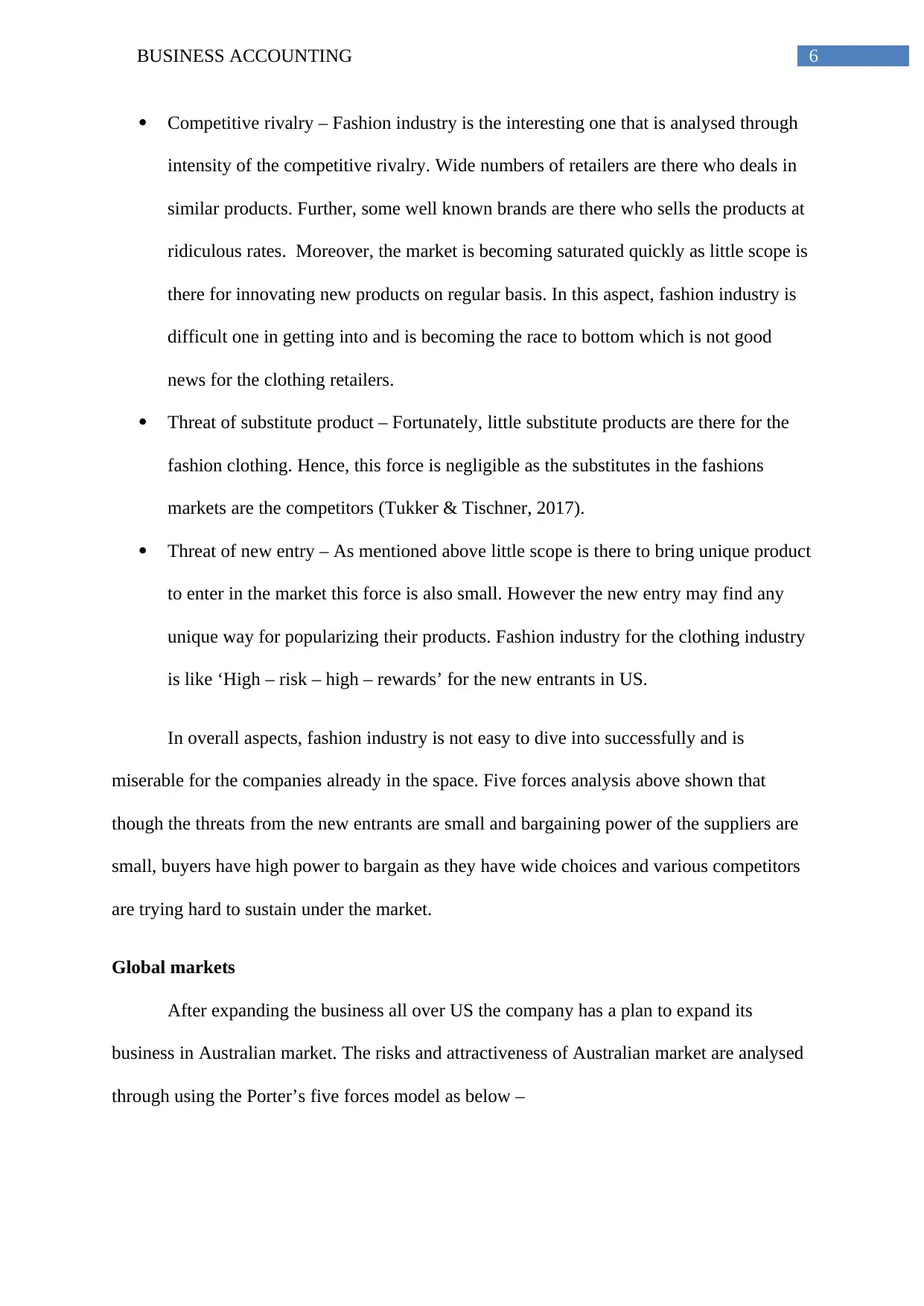
6BUSINESS ACCOUNTING
Competitive rivalry – Fashion industry is the interesting one that is analysed through
intensity of the competitive rivalry. Wide numbers of retailers are there who deals in
similar products. Further, some well known brands are there who sells the products at
ridiculous rates. Moreover, the market is becoming saturated quickly as little scope is
there for innovating new products on regular basis. In this aspect, fashion industry is
difficult one in getting into and is becoming the race to bottom which is not good
news for the clothing retailers.
Threat of substitute product – Fortunately, little substitute products are there for the
fashion clothing. Hence, this force is negligible as the substitutes in the fashions
markets are the competitors (Tukker & Tischner, 2017).
Threat of new entry – As mentioned above little scope is there to bring unique product
to enter in the market this force is also small. However the new entry may find any
unique way for popularizing their products. Fashion industry for the clothing industry
is like ‘High – risk – high – rewards’ for the new entrants in US.
In overall aspects, fashion industry is not easy to dive into successfully and is
miserable for the companies already in the space. Five forces analysis above shown that
though the threats from the new entrants are small and bargaining power of the suppliers are
small, buyers have high power to bargain as they have wide choices and various competitors
are trying hard to sustain under the market.
Global markets
After expanding the business all over US the company has a plan to expand its
business in Australian market. The risks and attractiveness of Australian market are analysed
through using the Porter’s five forces model as below –
Competitive rivalry – Fashion industry is the interesting one that is analysed through
intensity of the competitive rivalry. Wide numbers of retailers are there who deals in
similar products. Further, some well known brands are there who sells the products at
ridiculous rates. Moreover, the market is becoming saturated quickly as little scope is
there for innovating new products on regular basis. In this aspect, fashion industry is
difficult one in getting into and is becoming the race to bottom which is not good
news for the clothing retailers.
Threat of substitute product – Fortunately, little substitute products are there for the
fashion clothing. Hence, this force is negligible as the substitutes in the fashions
markets are the competitors (Tukker & Tischner, 2017).
Threat of new entry – As mentioned above little scope is there to bring unique product
to enter in the market this force is also small. However the new entry may find any
unique way for popularizing their products. Fashion industry for the clothing industry
is like ‘High – risk – high – rewards’ for the new entrants in US.
In overall aspects, fashion industry is not easy to dive into successfully and is
miserable for the companies already in the space. Five forces analysis above shown that
though the threats from the new entrants are small and bargaining power of the suppliers are
small, buyers have high power to bargain as they have wide choices and various competitors
are trying hard to sustain under the market.
Global markets
After expanding the business all over US the company has a plan to expand its
business in Australian market. The risks and attractiveness of Australian market are analysed
through using the Porter’s five forces model as below –
Paraphrase This Document
Need a fresh take? Get an instant paraphrase of this document with our AI Paraphraser
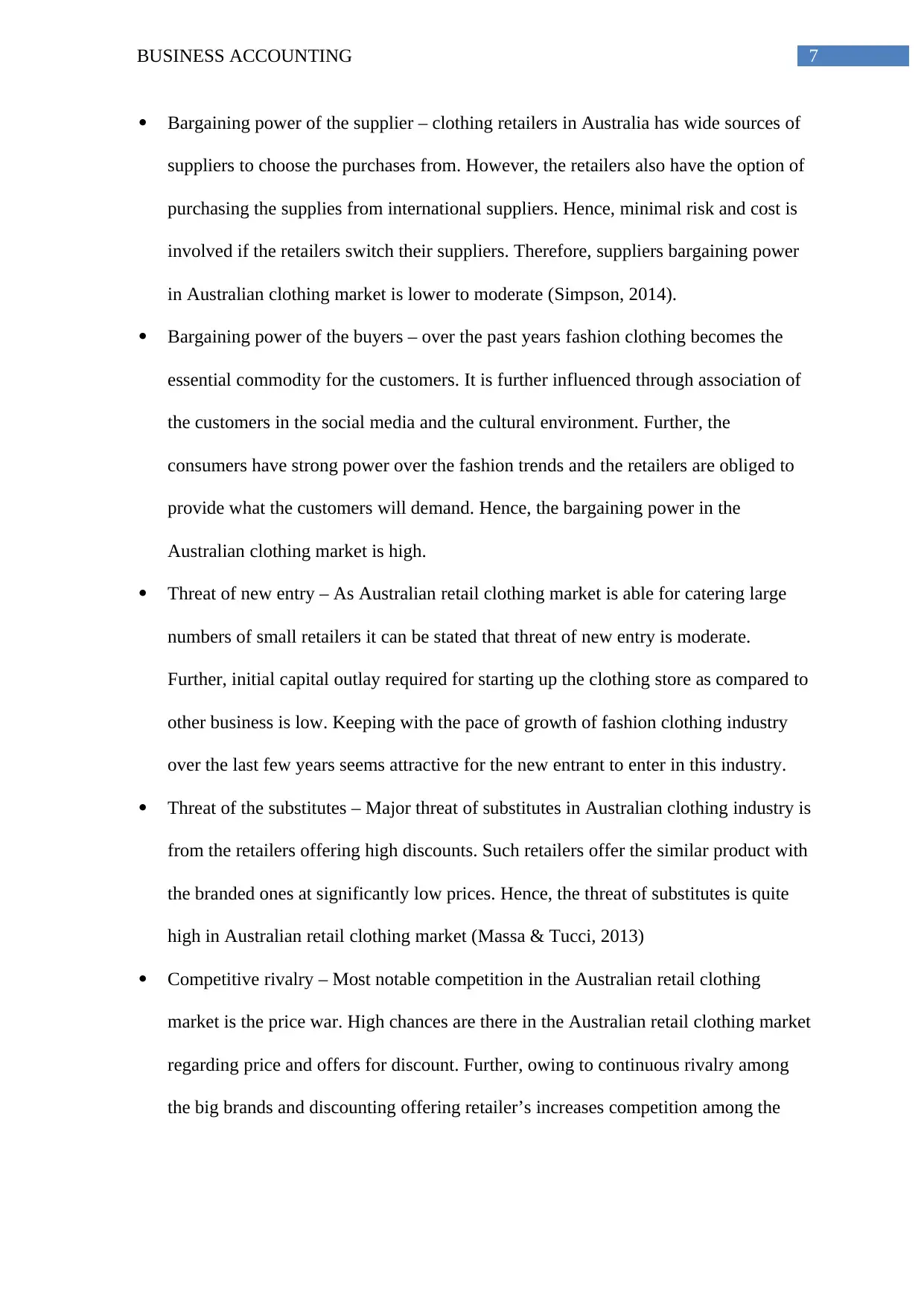
7BUSINESS ACCOUNTING
Bargaining power of the supplier – clothing retailers in Australia has wide sources of
suppliers to choose the purchases from. However, the retailers also have the option of
purchasing the supplies from international suppliers. Hence, minimal risk and cost is
involved if the retailers switch their suppliers. Therefore, suppliers bargaining power
in Australian clothing market is lower to moderate (Simpson, 2014).
Bargaining power of the buyers – over the past years fashion clothing becomes the
essential commodity for the customers. It is further influenced through association of
the customers in the social media and the cultural environment. Further, the
consumers have strong power over the fashion trends and the retailers are obliged to
provide what the customers will demand. Hence, the bargaining power in the
Australian clothing market is high.
Threat of new entry – As Australian retail clothing market is able for catering large
numbers of small retailers it can be stated that threat of new entry is moderate.
Further, initial capital outlay required for starting up the clothing store as compared to
other business is low. Keeping with the pace of growth of fashion clothing industry
over the last few years seems attractive for the new entrant to enter in this industry.
Threat of the substitutes – Major threat of substitutes in Australian clothing industry is
from the retailers offering high discounts. Such retailers offer the similar product with
the branded ones at significantly low prices. Hence, the threat of substitutes is quite
high in Australian retail clothing market (Massa & Tucci, 2013)
Competitive rivalry – Most notable competition in the Australian retail clothing
market is the price war. High chances are there in the Australian retail clothing market
regarding price and offers for discount. Further, owing to continuous rivalry among
the big brands and discounting offering retailer’s increases competition among the
Bargaining power of the supplier – clothing retailers in Australia has wide sources of
suppliers to choose the purchases from. However, the retailers also have the option of
purchasing the supplies from international suppliers. Hence, minimal risk and cost is
involved if the retailers switch their suppliers. Therefore, suppliers bargaining power
in Australian clothing market is lower to moderate (Simpson, 2014).
Bargaining power of the buyers – over the past years fashion clothing becomes the
essential commodity for the customers. It is further influenced through association of
the customers in the social media and the cultural environment. Further, the
consumers have strong power over the fashion trends and the retailers are obliged to
provide what the customers will demand. Hence, the bargaining power in the
Australian clothing market is high.
Threat of new entry – As Australian retail clothing market is able for catering large
numbers of small retailers it can be stated that threat of new entry is moderate.
Further, initial capital outlay required for starting up the clothing store as compared to
other business is low. Keeping with the pace of growth of fashion clothing industry
over the last few years seems attractive for the new entrant to enter in this industry.
Threat of the substitutes – Major threat of substitutes in Australian clothing industry is
from the retailers offering high discounts. Such retailers offer the similar product with
the branded ones at significantly low prices. Hence, the threat of substitutes is quite
high in Australian retail clothing market (Massa & Tucci, 2013)
Competitive rivalry – Most notable competition in the Australian retail clothing
market is the price war. High chances are there in the Australian retail clothing market
regarding price and offers for discount. Further, owing to continuous rivalry among
the big brands and discounting offering retailer’s increases competition among the
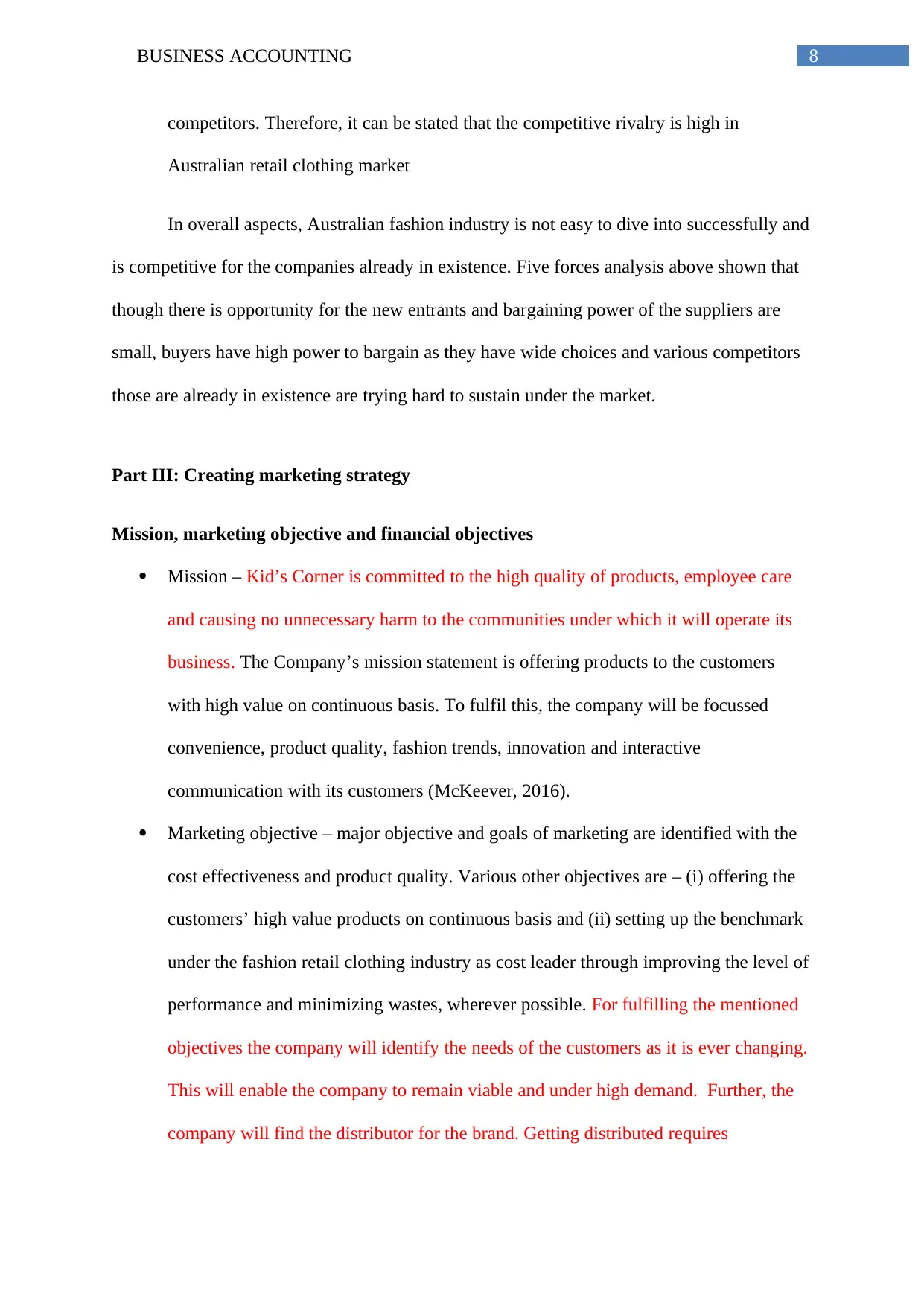
8BUSINESS ACCOUNTING
competitors. Therefore, it can be stated that the competitive rivalry is high in
Australian retail clothing market
In overall aspects, Australian fashion industry is not easy to dive into successfully and
is competitive for the companies already in existence. Five forces analysis above shown that
though there is opportunity for the new entrants and bargaining power of the suppliers are
small, buyers have high power to bargain as they have wide choices and various competitors
those are already in existence are trying hard to sustain under the market.
Part III: Creating marketing strategy
Mission, marketing objective and financial objectives
Mission – Kid’s Corner is committed to the high quality of products, employee care
and causing no unnecessary harm to the communities under which it will operate its
business. The Company’s mission statement is offering products to the customers
with high value on continuous basis. To fulfil this, the company will be focussed
convenience, product quality, fashion trends, innovation and interactive
communication with its customers (McKeever, 2016).
Marketing objective – major objective and goals of marketing are identified with the
cost effectiveness and product quality. Various other objectives are – (i) offering the
customers’ high value products on continuous basis and (ii) setting up the benchmark
under the fashion retail clothing industry as cost leader through improving the level of
performance and minimizing wastes, wherever possible. For fulfilling the mentioned
objectives the company will identify the needs of the customers as it is ever changing.
This will enable the company to remain viable and under high demand. Further, the
company will find the distributor for the brand. Getting distributed requires
competitors. Therefore, it can be stated that the competitive rivalry is high in
Australian retail clothing market
In overall aspects, Australian fashion industry is not easy to dive into successfully and
is competitive for the companies already in existence. Five forces analysis above shown that
though there is opportunity for the new entrants and bargaining power of the suppliers are
small, buyers have high power to bargain as they have wide choices and various competitors
those are already in existence are trying hard to sustain under the market.
Part III: Creating marketing strategy
Mission, marketing objective and financial objectives
Mission – Kid’s Corner is committed to the high quality of products, employee care
and causing no unnecessary harm to the communities under which it will operate its
business. The Company’s mission statement is offering products to the customers
with high value on continuous basis. To fulfil this, the company will be focussed
convenience, product quality, fashion trends, innovation and interactive
communication with its customers (McKeever, 2016).
Marketing objective – major objective and goals of marketing are identified with the
cost effectiveness and product quality. Various other objectives are – (i) offering the
customers’ high value products on continuous basis and (ii) setting up the benchmark
under the fashion retail clothing industry as cost leader through improving the level of
performance and minimizing wastes, wherever possible. For fulfilling the mentioned
objectives the company will identify the needs of the customers as it is ever changing.
This will enable the company to remain viable and under high demand. Further, the
company will find the distributor for the brand. Getting distributed requires
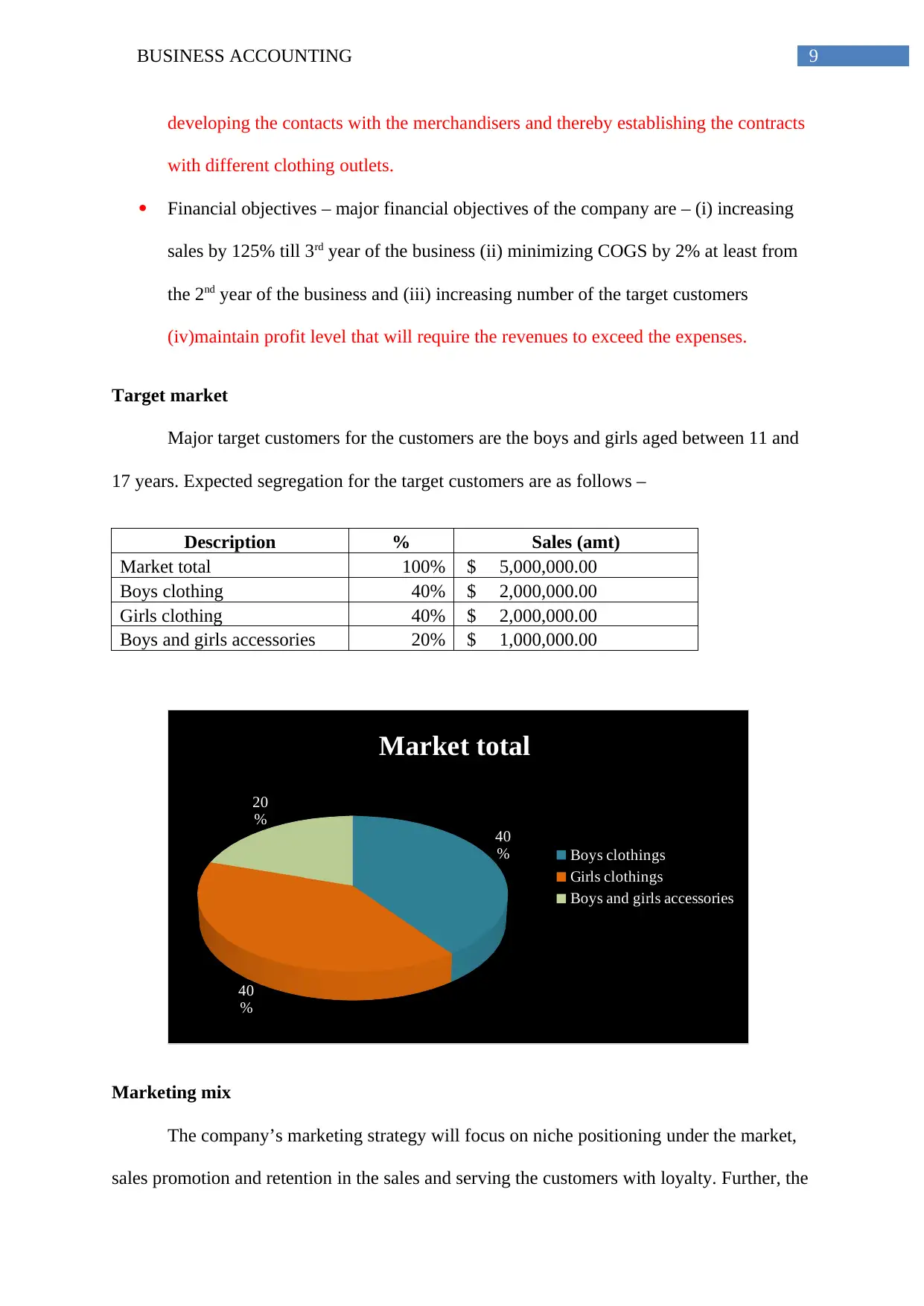
9BUSINESS ACCOUNTING
developing the contacts with the merchandisers and thereby establishing the contracts
with different clothing outlets.
Financial objectives – major financial objectives of the company are – (i) increasing
sales by 125% till 3rd year of the business (ii) minimizing COGS by 2% at least from
the 2nd year of the business and (iii) increasing number of the target customers
(iv)maintain profit level that will require the revenues to exceed the expenses.
Target market
Major target customers for the customers are the boys and girls aged between 11 and
17 years. Expected segregation for the target customers are as follows –
Description % Sales (amt)
Market total 100% $ 5,000,000.00
Boys clothing 40% $ 2,000,000.00
Girls clothing 40% $ 2,000,000.00
Boys and girls accessories 20% $ 1,000,000.00
40
%
40
%
20
%
Market total
Boys clothings
Girls clothings
Boys and girls accessories
Marketing mix
The company’s marketing strategy will focus on niche positioning under the market,
sales promotion and retention in the sales and serving the customers with loyalty. Further, the
developing the contacts with the merchandisers and thereby establishing the contracts
with different clothing outlets.
Financial objectives – major financial objectives of the company are – (i) increasing
sales by 125% till 3rd year of the business (ii) minimizing COGS by 2% at least from
the 2nd year of the business and (iii) increasing number of the target customers
(iv)maintain profit level that will require the revenues to exceed the expenses.
Target market
Major target customers for the customers are the boys and girls aged between 11 and
17 years. Expected segregation for the target customers are as follows –
Description % Sales (amt)
Market total 100% $ 5,000,000.00
Boys clothing 40% $ 2,000,000.00
Girls clothing 40% $ 2,000,000.00
Boys and girls accessories 20% $ 1,000,000.00
40
%
40
%
20
%
Market total
Boys clothings
Girls clothings
Boys and girls accessories
Marketing mix
The company’s marketing strategy will focus on niche positioning under the market,
sales promotion and retention in the sales and serving the customers with loyalty. Further, the
Secure Best Marks with AI Grader
Need help grading? Try our AI Grader for instant feedback on your assignments.
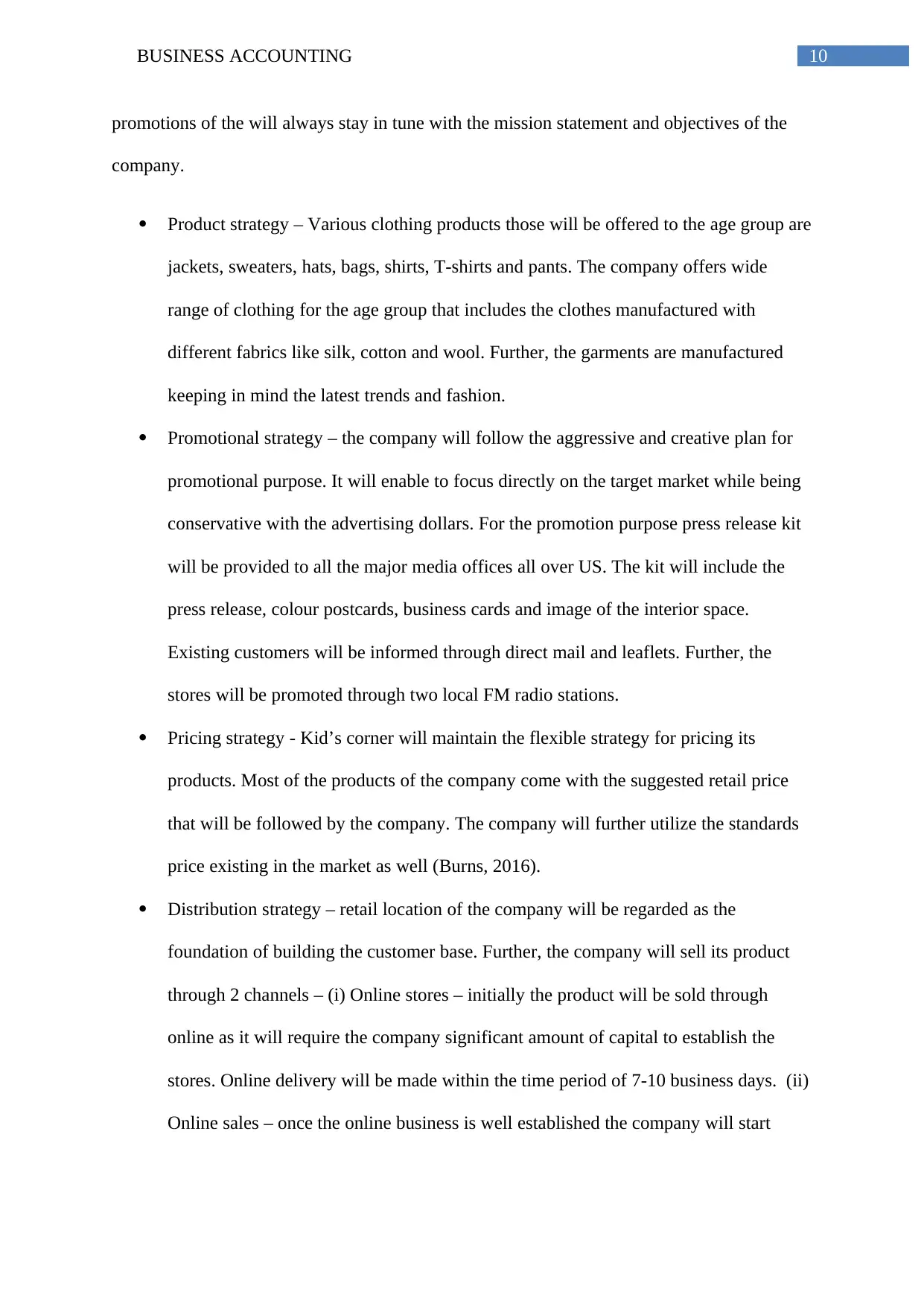
10BUSINESS ACCOUNTING
promotions of the will always stay in tune with the mission statement and objectives of the
company.
Product strategy – Various clothing products those will be offered to the age group are
jackets, sweaters, hats, bags, shirts, T-shirts and pants. The company offers wide
range of clothing for the age group that includes the clothes manufactured with
different fabrics like silk, cotton and wool. Further, the garments are manufactured
keeping in mind the latest trends and fashion.
Promotional strategy – the company will follow the aggressive and creative plan for
promotional purpose. It will enable to focus directly on the target market while being
conservative with the advertising dollars. For the promotion purpose press release kit
will be provided to all the major media offices all over US. The kit will include the
press release, colour postcards, business cards and image of the interior space.
Existing customers will be informed through direct mail and leaflets. Further, the
stores will be promoted through two local FM radio stations.
Pricing strategy - Kid’s corner will maintain the flexible strategy for pricing its
products. Most of the products of the company come with the suggested retail price
that will be followed by the company. The company will further utilize the standards
price existing in the market as well (Burns, 2016).
Distribution strategy – retail location of the company will be regarded as the
foundation of building the customer base. Further, the company will sell its product
through 2 channels – (i) Online stores – initially the product will be sold through
online as it will require the company significant amount of capital to establish the
stores. Online delivery will be made within the time period of 7-10 business days. (ii)
Online sales – once the online business is well established the company will start
promotions of the will always stay in tune with the mission statement and objectives of the
company.
Product strategy – Various clothing products those will be offered to the age group are
jackets, sweaters, hats, bags, shirts, T-shirts and pants. The company offers wide
range of clothing for the age group that includes the clothes manufactured with
different fabrics like silk, cotton and wool. Further, the garments are manufactured
keeping in mind the latest trends and fashion.
Promotional strategy – the company will follow the aggressive and creative plan for
promotional purpose. It will enable to focus directly on the target market while being
conservative with the advertising dollars. For the promotion purpose press release kit
will be provided to all the major media offices all over US. The kit will include the
press release, colour postcards, business cards and image of the interior space.
Existing customers will be informed through direct mail and leaflets. Further, the
stores will be promoted through two local FM radio stations.
Pricing strategy - Kid’s corner will maintain the flexible strategy for pricing its
products. Most of the products of the company come with the suggested retail price
that will be followed by the company. The company will further utilize the standards
price existing in the market as well (Burns, 2016).
Distribution strategy – retail location of the company will be regarded as the
foundation of building the customer base. Further, the company will sell its product
through 2 channels – (i) Online stores – initially the product will be sold through
online as it will require the company significant amount of capital to establish the
stores. Online delivery will be made within the time period of 7-10 business days. (ii)
Online sales – once the online business is well established the company will start
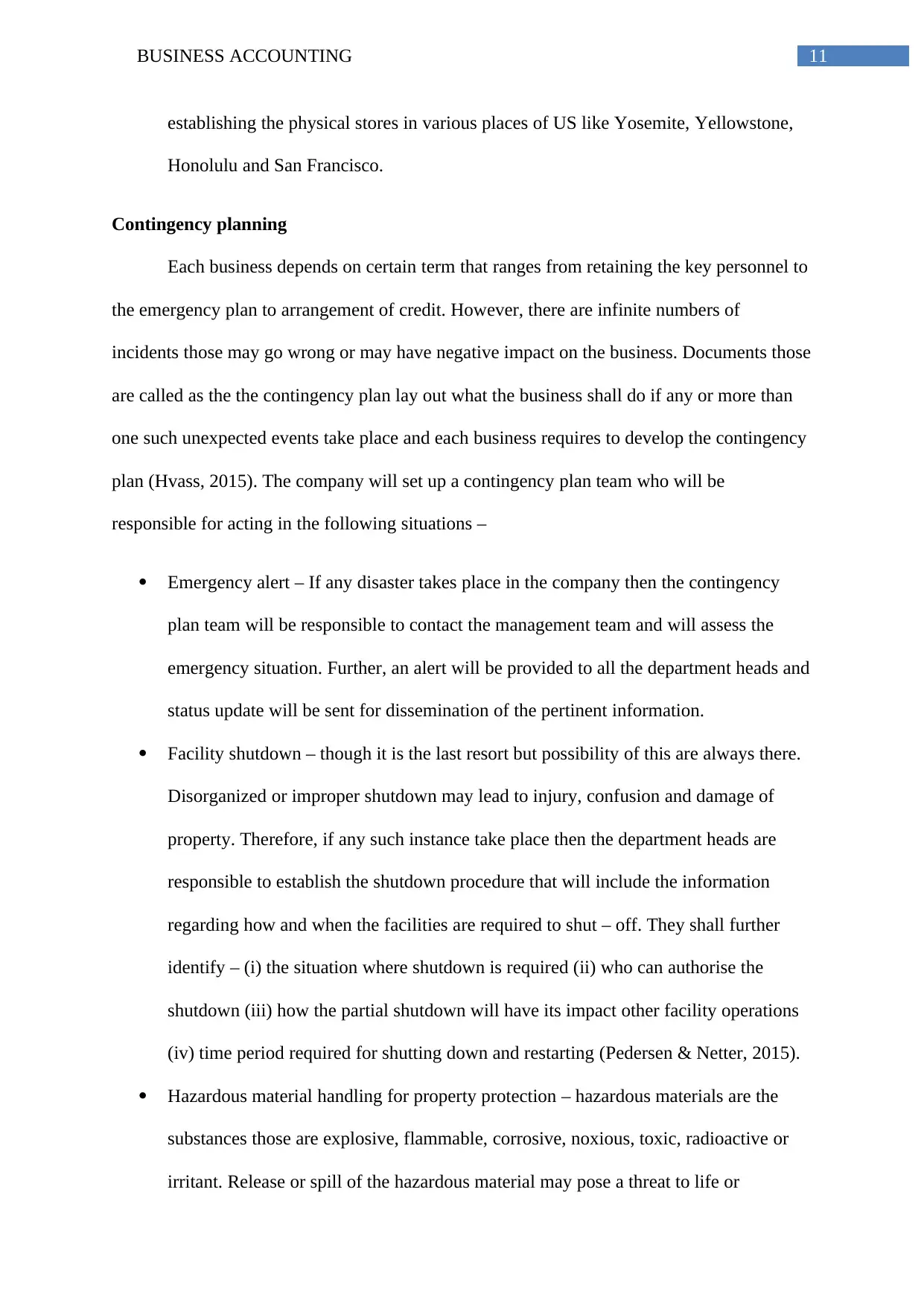
11BUSINESS ACCOUNTING
establishing the physical stores in various places of US like Yosemite, Yellowstone,
Honolulu and San Francisco.
Contingency planning
Each business depends on certain term that ranges from retaining the key personnel to
the emergency plan to arrangement of credit. However, there are infinite numbers of
incidents those may go wrong or may have negative impact on the business. Documents those
are called as the the contingency plan lay out what the business shall do if any or more than
one such unexpected events take place and each business requires to develop the contingency
plan (Hvass, 2015). The company will set up a contingency plan team who will be
responsible for acting in the following situations –
Emergency alert – If any disaster takes place in the company then the contingency
plan team will be responsible to contact the management team and will assess the
emergency situation. Further, an alert will be provided to all the department heads and
status update will be sent for dissemination of the pertinent information.
Facility shutdown – though it is the last resort but possibility of this are always there.
Disorganized or improper shutdown may lead to injury, confusion and damage of
property. Therefore, if any such instance take place then the department heads are
responsible to establish the shutdown procedure that will include the information
regarding how and when the facilities are required to shut – off. They shall further
identify – (i) the situation where shutdown is required (ii) who can authorise the
shutdown (iii) how the partial shutdown will have its impact other facility operations
(iv) time period required for shutting down and restarting (Pedersen & Netter, 2015).
Hazardous material handling for property protection – hazardous materials are the
substances those are explosive, flammable, corrosive, noxious, toxic, radioactive or
irritant. Release or spill of the hazardous material may pose a threat to life or
establishing the physical stores in various places of US like Yosemite, Yellowstone,
Honolulu and San Francisco.
Contingency planning
Each business depends on certain term that ranges from retaining the key personnel to
the emergency plan to arrangement of credit. However, there are infinite numbers of
incidents those may go wrong or may have negative impact on the business. Documents those
are called as the the contingency plan lay out what the business shall do if any or more than
one such unexpected events take place and each business requires to develop the contingency
plan (Hvass, 2015). The company will set up a contingency plan team who will be
responsible for acting in the following situations –
Emergency alert – If any disaster takes place in the company then the contingency
plan team will be responsible to contact the management team and will assess the
emergency situation. Further, an alert will be provided to all the department heads and
status update will be sent for dissemination of the pertinent information.
Facility shutdown – though it is the last resort but possibility of this are always there.
Disorganized or improper shutdown may lead to injury, confusion and damage of
property. Therefore, if any such instance take place then the department heads are
responsible to establish the shutdown procedure that will include the information
regarding how and when the facilities are required to shut – off. They shall further
identify – (i) the situation where shutdown is required (ii) who can authorise the
shutdown (iii) how the partial shutdown will have its impact other facility operations
(iv) time period required for shutting down and restarting (Pedersen & Netter, 2015).
Hazardous material handling for property protection – hazardous materials are the
substances those are explosive, flammable, corrosive, noxious, toxic, radioactive or
irritant. Release or spill of the hazardous material may pose a threat to life or
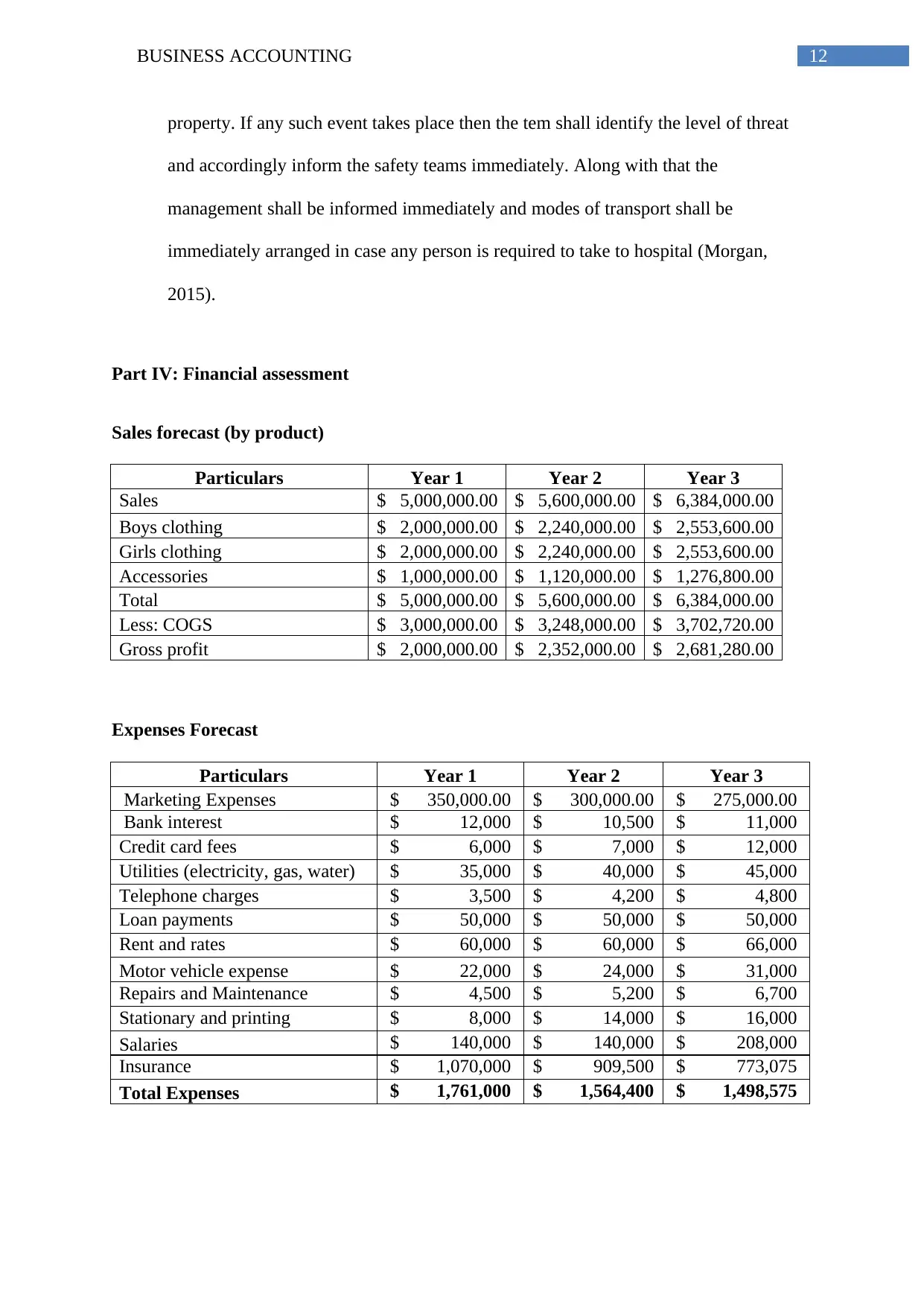
12BUSINESS ACCOUNTING
property. If any such event takes place then the tem shall identify the level of threat
and accordingly inform the safety teams immediately. Along with that the
management shall be informed immediately and modes of transport shall be
immediately arranged in case any person is required to take to hospital (Morgan,
2015).
Part IV: Financial assessment
Sales forecast (by product)
Particulars Year 1 Year 2 Year 3
Sales $ 5,000,000.00 $ 5,600,000.00 $ 6,384,000.00
Boys clothing $ 2,000,000.00 $ 2,240,000.00 $ 2,553,600.00
Girls clothing $ 2,000,000.00 $ 2,240,000.00 $ 2,553,600.00
Accessories $ 1,000,000.00 $ 1,120,000.00 $ 1,276,800.00
Total $ 5,000,000.00 $ 5,600,000.00 $ 6,384,000.00
Less: COGS $ 3,000,000.00 $ 3,248,000.00 $ 3,702,720.00
Gross profit $ 2,000,000.00 $ 2,352,000.00 $ 2,681,280.00
Expenses Forecast
Particulars Year 1 Year 2 Year 3
Marketing Expenses $ 350,000.00 $ 300,000.00 $ 275,000.00
Bank interest $ 12,000 $ 10,500 $ 11,000
Credit card fees $ 6,000 $ 7,000 $ 12,000
Utilities (electricity, gas, water) $ 35,000 $ 40,000 $ 45,000
Telephone charges $ 3,500 $ 4,200 $ 4,800
Loan payments $ 50,000 $ 50,000 $ 50,000
Rent and rates $ 60,000 $ 60,000 $ 66,000
Motor vehicle expense $ 22,000 $ 24,000 $ 31,000
Repairs and Maintenance $ 4,500 $ 5,200 $ 6,700
Stationary and printing $ 8,000 $ 14,000 $ 16,000
Salaries $ 140,000 $ 140,000 $ 208,000
Insurance $ 1,070,000 $ 909,500 $ 773,075
Total Expenses $ 1,761,000 $ 1,564,400 $ 1,498,575
property. If any such event takes place then the tem shall identify the level of threat
and accordingly inform the safety teams immediately. Along with that the
management shall be informed immediately and modes of transport shall be
immediately arranged in case any person is required to take to hospital (Morgan,
2015).
Part IV: Financial assessment
Sales forecast (by product)
Particulars Year 1 Year 2 Year 3
Sales $ 5,000,000.00 $ 5,600,000.00 $ 6,384,000.00
Boys clothing $ 2,000,000.00 $ 2,240,000.00 $ 2,553,600.00
Girls clothing $ 2,000,000.00 $ 2,240,000.00 $ 2,553,600.00
Accessories $ 1,000,000.00 $ 1,120,000.00 $ 1,276,800.00
Total $ 5,000,000.00 $ 5,600,000.00 $ 6,384,000.00
Less: COGS $ 3,000,000.00 $ 3,248,000.00 $ 3,702,720.00
Gross profit $ 2,000,000.00 $ 2,352,000.00 $ 2,681,280.00
Expenses Forecast
Particulars Year 1 Year 2 Year 3
Marketing Expenses $ 350,000.00 $ 300,000.00 $ 275,000.00
Bank interest $ 12,000 $ 10,500 $ 11,000
Credit card fees $ 6,000 $ 7,000 $ 12,000
Utilities (electricity, gas, water) $ 35,000 $ 40,000 $ 45,000
Telephone charges $ 3,500 $ 4,200 $ 4,800
Loan payments $ 50,000 $ 50,000 $ 50,000
Rent and rates $ 60,000 $ 60,000 $ 66,000
Motor vehicle expense $ 22,000 $ 24,000 $ 31,000
Repairs and Maintenance $ 4,500 $ 5,200 $ 6,700
Stationary and printing $ 8,000 $ 14,000 $ 16,000
Salaries $ 140,000 $ 140,000 $ 208,000
Insurance $ 1,070,000 $ 909,500 $ 773,075
Total Expenses $ 1,761,000 $ 1,564,400 $ 1,498,575
Paraphrase This Document
Need a fresh take? Get an instant paraphrase of this document with our AI Paraphraser
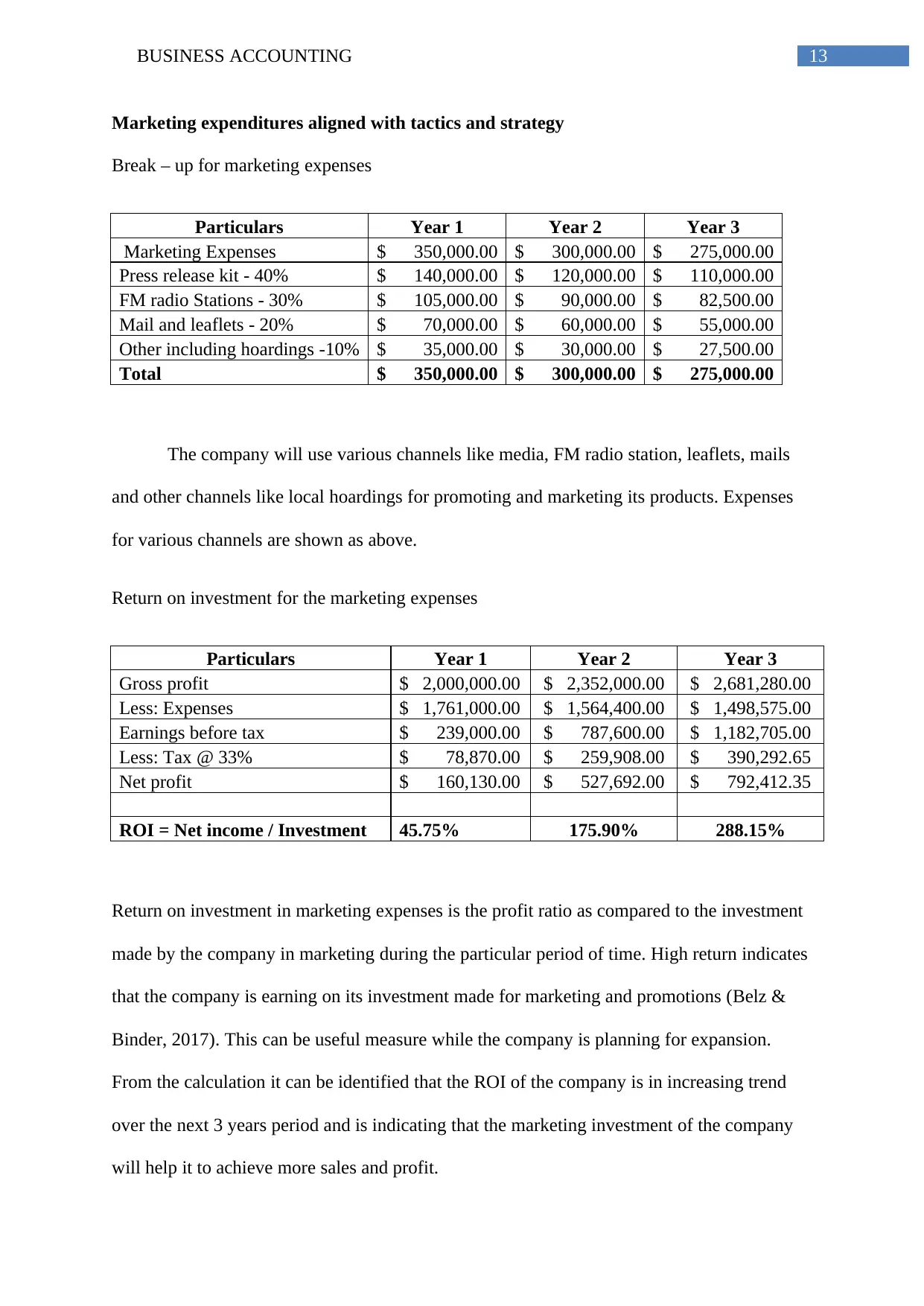
13BUSINESS ACCOUNTING
Marketing expenditures aligned with tactics and strategy
Break – up for marketing expenses
Particulars Year 1 Year 2 Year 3
Marketing Expenses $ 350,000.00 $ 300,000.00 $ 275,000.00
Press release kit - 40% $ 140,000.00 $ 120,000.00 $ 110,000.00
FM radio Stations - 30% $ 105,000.00 $ 90,000.00 $ 82,500.00
Mail and leaflets - 20% $ 70,000.00 $ 60,000.00 $ 55,000.00
Other including hoardings -10% $ 35,000.00 $ 30,000.00 $ 27,500.00
Total $ 350,000.00 $ 300,000.00 $ 275,000.00
The company will use various channels like media, FM radio station, leaflets, mails
and other channels like local hoardings for promoting and marketing its products. Expenses
for various channels are shown as above.
Return on investment for the marketing expenses
Particulars Year 1 Year 2 Year 3
Gross profit $ 2,000,000.00 $ 2,352,000.00 $ 2,681,280.00
Less: Expenses $ 1,761,000.00 $ 1,564,400.00 $ 1,498,575.00
Earnings before tax $ 239,000.00 $ 787,600.00 $ 1,182,705.00
Less: Tax @ 33% $ 78,870.00 $ 259,908.00 $ 390,292.65
Net profit $ 160,130.00 $ 527,692.00 $ 792,412.35
ROI = Net income / Investment 45.75% 175.90% 288.15%
Return on investment in marketing expenses is the profit ratio as compared to the investment
made by the company in marketing during the particular period of time. High return indicates
that the company is earning on its investment made for marketing and promotions (Belz &
Binder, 2017). This can be useful measure while the company is planning for expansion.
From the calculation it can be identified that the ROI of the company is in increasing trend
over the next 3 years period and is indicating that the marketing investment of the company
will help it to achieve more sales and profit.
Marketing expenditures aligned with tactics and strategy
Break – up for marketing expenses
Particulars Year 1 Year 2 Year 3
Marketing Expenses $ 350,000.00 $ 300,000.00 $ 275,000.00
Press release kit - 40% $ 140,000.00 $ 120,000.00 $ 110,000.00
FM radio Stations - 30% $ 105,000.00 $ 90,000.00 $ 82,500.00
Mail and leaflets - 20% $ 70,000.00 $ 60,000.00 $ 55,000.00
Other including hoardings -10% $ 35,000.00 $ 30,000.00 $ 27,500.00
Total $ 350,000.00 $ 300,000.00 $ 275,000.00
The company will use various channels like media, FM radio station, leaflets, mails
and other channels like local hoardings for promoting and marketing its products. Expenses
for various channels are shown as above.
Return on investment for the marketing expenses
Particulars Year 1 Year 2 Year 3
Gross profit $ 2,000,000.00 $ 2,352,000.00 $ 2,681,280.00
Less: Expenses $ 1,761,000.00 $ 1,564,400.00 $ 1,498,575.00
Earnings before tax $ 239,000.00 $ 787,600.00 $ 1,182,705.00
Less: Tax @ 33% $ 78,870.00 $ 259,908.00 $ 390,292.65
Net profit $ 160,130.00 $ 527,692.00 $ 792,412.35
ROI = Net income / Investment 45.75% 175.90% 288.15%
Return on investment in marketing expenses is the profit ratio as compared to the investment
made by the company in marketing during the particular period of time. High return indicates
that the company is earning on its investment made for marketing and promotions (Belz &
Binder, 2017). This can be useful measure while the company is planning for expansion.
From the calculation it can be identified that the ROI of the company is in increasing trend
over the next 3 years period and is indicating that the marketing investment of the company
will help it to achieve more sales and profit.
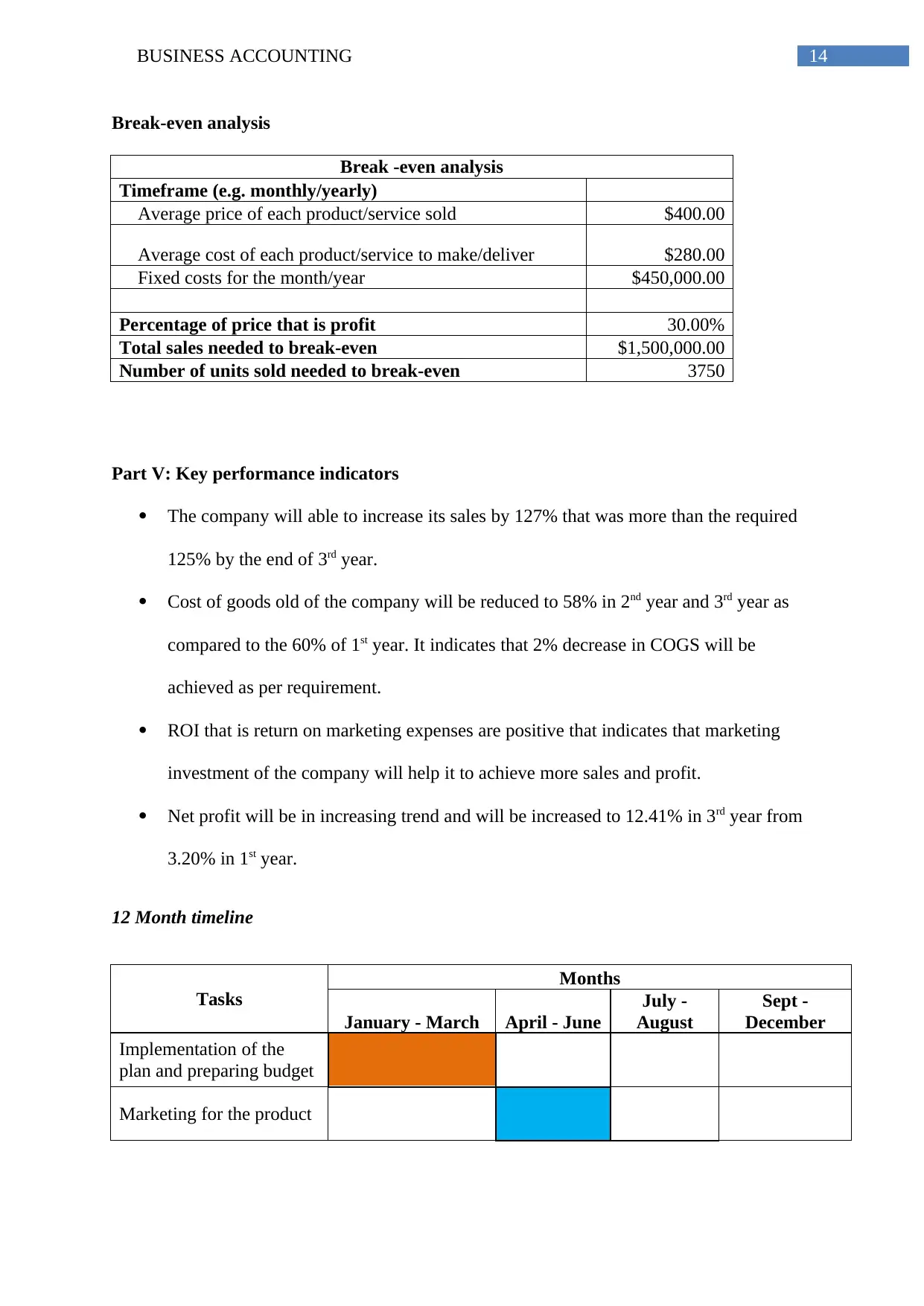
14BUSINESS ACCOUNTING
Break-even analysis
Break -even analysis
Timeframe (e.g. monthly/yearly)
Average price of each product/service sold $400.00
Average cost of each product/service to make/deliver $280.00
Fixed costs for the month/year $450,000.00
Percentage of price that is profit 30.00%
Total sales needed to break-even $1,500,000.00
Number of units sold needed to break-even 3750
Part V: Key performance indicators
The company will able to increase its sales by 127% that was more than the required
125% by the end of 3rd year.
Cost of goods old of the company will be reduced to 58% in 2nd year and 3rd year as
compared to the 60% of 1st year. It indicates that 2% decrease in COGS will be
achieved as per requirement.
ROI that is return on marketing expenses are positive that indicates that marketing
investment of the company will help it to achieve more sales and profit.
Net profit will be in increasing trend and will be increased to 12.41% in 3rd year from
3.20% in 1st year.
12 Month timeline
Tasks
Months
January - March April - June
July -
August
Sept -
December
Implementation of the
plan and preparing budget
Marketing for the product
Break-even analysis
Break -even analysis
Timeframe (e.g. monthly/yearly)
Average price of each product/service sold $400.00
Average cost of each product/service to make/deliver $280.00
Fixed costs for the month/year $450,000.00
Percentage of price that is profit 30.00%
Total sales needed to break-even $1,500,000.00
Number of units sold needed to break-even 3750
Part V: Key performance indicators
The company will able to increase its sales by 127% that was more than the required
125% by the end of 3rd year.
Cost of goods old of the company will be reduced to 58% in 2nd year and 3rd year as
compared to the 60% of 1st year. It indicates that 2% decrease in COGS will be
achieved as per requirement.
ROI that is return on marketing expenses are positive that indicates that marketing
investment of the company will help it to achieve more sales and profit.
Net profit will be in increasing trend and will be increased to 12.41% in 3rd year from
3.20% in 1st year.
12 Month timeline
Tasks
Months
January - March April - June
July -
August
Sept -
December
Implementation of the
plan and preparing budget
Marketing for the product
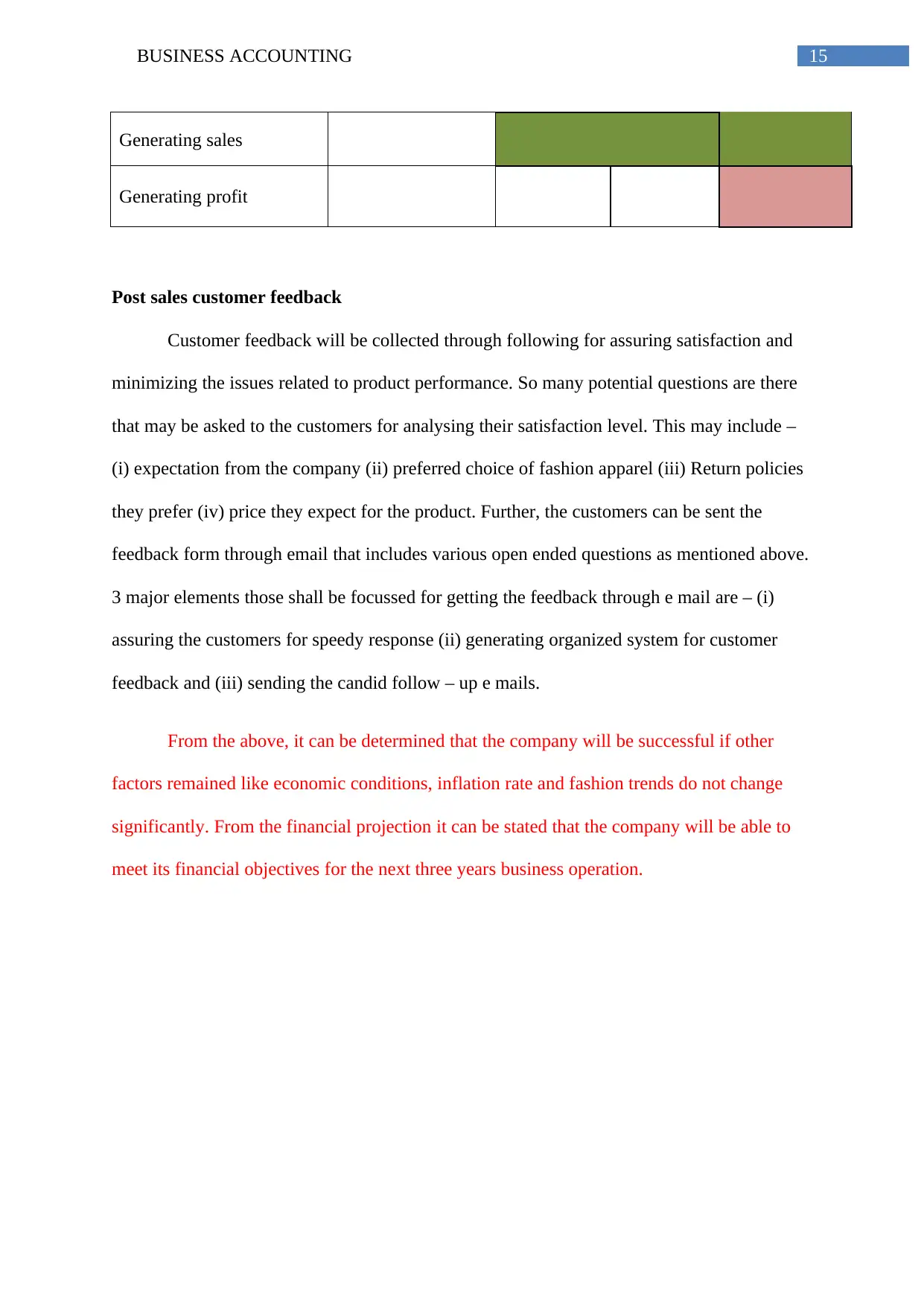
15BUSINESS ACCOUNTING
Generating sales
Generating profit
Post sales customer feedback
Customer feedback will be collected through following for assuring satisfaction and
minimizing the issues related to product performance. So many potential questions are there
that may be asked to the customers for analysing their satisfaction level. This may include –
(i) expectation from the company (ii) preferred choice of fashion apparel (iii) Return policies
they prefer (iv) price they expect for the product. Further, the customers can be sent the
feedback form through email that includes various open ended questions as mentioned above.
3 major elements those shall be focussed for getting the feedback through e mail are – (i)
assuring the customers for speedy response (ii) generating organized system for customer
feedback and (iii) sending the candid follow – up e mails.
From the above, it can be determined that the company will be successful if other
factors remained like economic conditions, inflation rate and fashion trends do not change
significantly. From the financial projection it can be stated that the company will be able to
meet its financial objectives for the next three years business operation.
Generating sales
Generating profit
Post sales customer feedback
Customer feedback will be collected through following for assuring satisfaction and
minimizing the issues related to product performance. So many potential questions are there
that may be asked to the customers for analysing their satisfaction level. This may include –
(i) expectation from the company (ii) preferred choice of fashion apparel (iii) Return policies
they prefer (iv) price they expect for the product. Further, the customers can be sent the
feedback form through email that includes various open ended questions as mentioned above.
3 major elements those shall be focussed for getting the feedback through e mail are – (i)
assuring the customers for speedy response (ii) generating organized system for customer
feedback and (iii) sending the candid follow – up e mails.
From the above, it can be determined that the company will be successful if other
factors remained like economic conditions, inflation rate and fashion trends do not change
significantly. From the financial projection it can be stated that the company will be able to
meet its financial objectives for the next three years business operation.
Secure Best Marks with AI Grader
Need help grading? Try our AI Grader for instant feedback on your assignments.
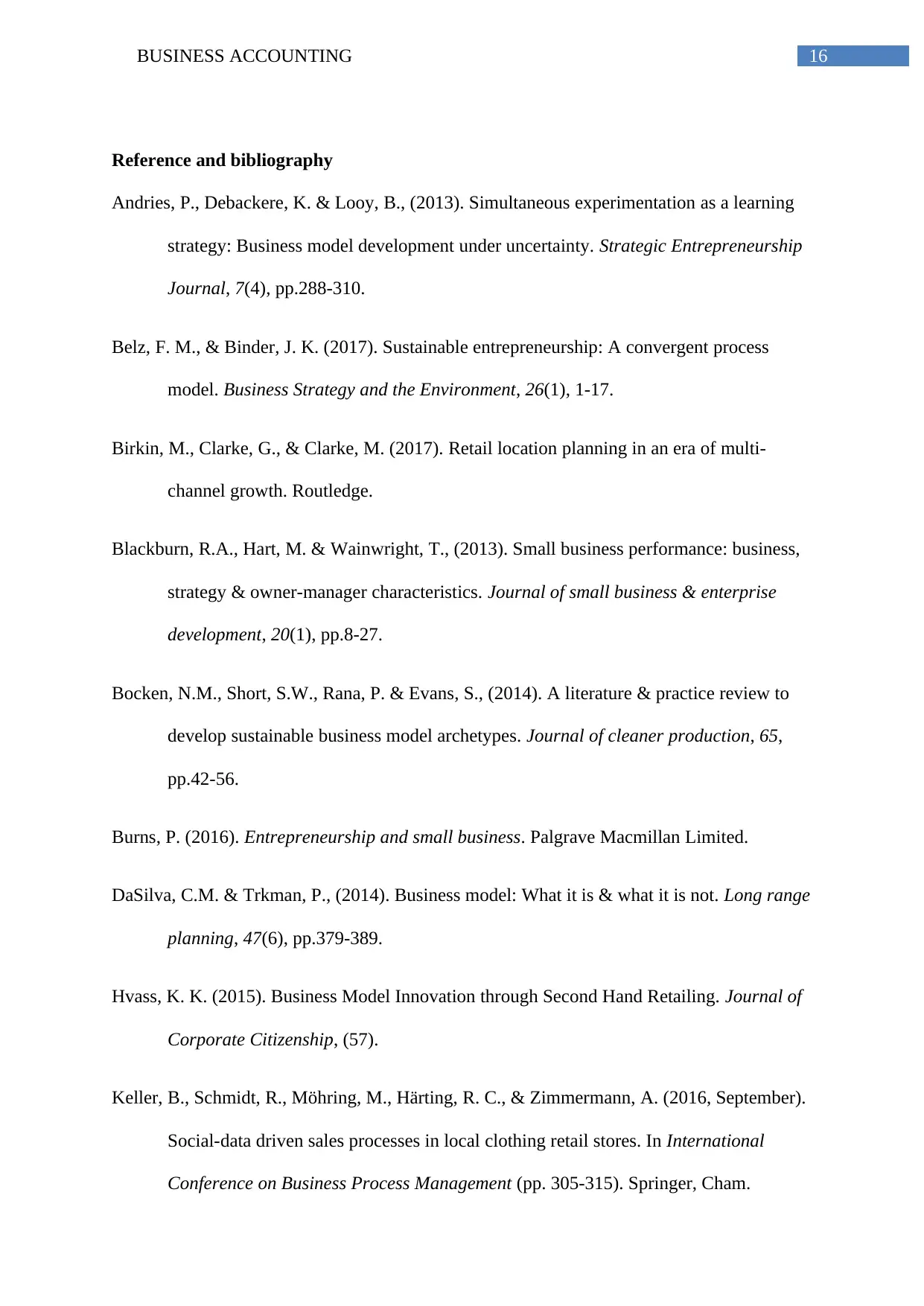
16BUSINESS ACCOUNTING
Reference and bibliography
Andries, P., Debackere, K. & Looy, B., (2013). Simultaneous experimentation as a learning
strategy: Business model development under uncertainty. Strategic Entrepreneurship
Journal, 7(4), pp.288-310.
Belz, F. M., & Binder, J. K. (2017). Sustainable entrepreneurship: A convergent process
model. Business Strategy and the Environment, 26(1), 1-17.
Birkin, M., Clarke, G., & Clarke, M. (2017). Retail location planning in an era of multi-
channel growth. Routledge.
Blackburn, R.A., Hart, M. & Wainwright, T., (2013). Small business performance: business,
strategy & owner-manager characteristics. Journal of small business & enterprise
development, 20(1), pp.8-27.
Bocken, N.M., Short, S.W., Rana, P. & Evans, S., (2014). A literature & practice review to
develop sustainable business model archetypes. Journal of cleaner production, 65,
pp.42-56.
Burns, P. (2016). Entrepreneurship and small business. Palgrave Macmillan Limited.
DaSilva, C.M. & Trkman, P., (2014). Business model: What it is & what it is not. Long range
planning, 47(6), pp.379-389.
Hvass, K. K. (2015). Business Model Innovation through Second Hand Retailing. Journal of
Corporate Citizenship, (57).
Keller, B., Schmidt, R., Möhring, M., Härting, R. C., & Zimmermann, A. (2016, September).
Social-data driven sales processes in local clothing retail stores. In International
Conference on Business Process Management (pp. 305-315). Springer, Cham.
Reference and bibliography
Andries, P., Debackere, K. & Looy, B., (2013). Simultaneous experimentation as a learning
strategy: Business model development under uncertainty. Strategic Entrepreneurship
Journal, 7(4), pp.288-310.
Belz, F. M., & Binder, J. K. (2017). Sustainable entrepreneurship: A convergent process
model. Business Strategy and the Environment, 26(1), 1-17.
Birkin, M., Clarke, G., & Clarke, M. (2017). Retail location planning in an era of multi-
channel growth. Routledge.
Blackburn, R.A., Hart, M. & Wainwright, T., (2013). Small business performance: business,
strategy & owner-manager characteristics. Journal of small business & enterprise
development, 20(1), pp.8-27.
Bocken, N.M., Short, S.W., Rana, P. & Evans, S., (2014). A literature & practice review to
develop sustainable business model archetypes. Journal of cleaner production, 65,
pp.42-56.
Burns, P. (2016). Entrepreneurship and small business. Palgrave Macmillan Limited.
DaSilva, C.M. & Trkman, P., (2014). Business model: What it is & what it is not. Long range
planning, 47(6), pp.379-389.
Hvass, K. K. (2015). Business Model Innovation through Second Hand Retailing. Journal of
Corporate Citizenship, (57).
Keller, B., Schmidt, R., Möhring, M., Härting, R. C., & Zimmermann, A. (2016, September).
Social-data driven sales processes in local clothing retail stores. In International
Conference on Business Process Management (pp. 305-315). Springer, Cham.
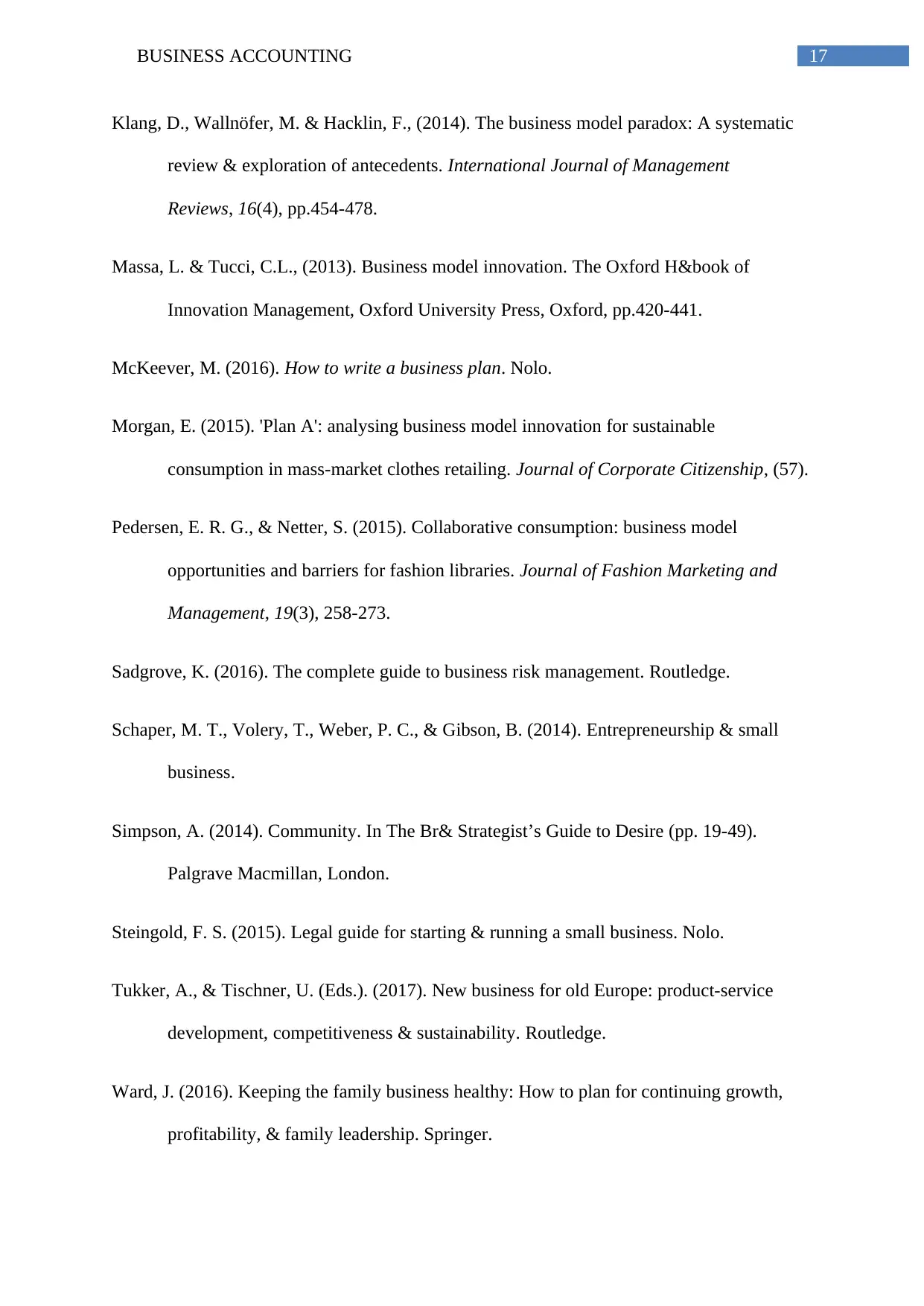
17BUSINESS ACCOUNTING
Klang, D., Wallnöfer, M. & Hacklin, F., (2014). The business model paradox: A systematic
review & exploration of antecedents. International Journal of Management
Reviews, 16(4), pp.454-478.
Massa, L. & Tucci, C.L., (2013). Business model innovation. The Oxford H&book of
Innovation Management, Oxford University Press, Oxford, pp.420-441.
McKeever, M. (2016). How to write a business plan. Nolo.
Morgan, E. (2015). 'Plan A': analysing business model innovation for sustainable
consumption in mass-market clothes retailing. Journal of Corporate Citizenship, (57).
Pedersen, E. R. G., & Netter, S. (2015). Collaborative consumption: business model
opportunities and barriers for fashion libraries. Journal of Fashion Marketing and
Management, 19(3), 258-273.
Sadgrove, K. (2016). The complete guide to business risk management. Routledge.
Schaper, M. T., Volery, T., Weber, P. C., & Gibson, B. (2014). Entrepreneurship & small
business.
Simpson, A. (2014). Community. In The Br& Strategist’s Guide to Desire (pp. 19-49).
Palgrave Macmillan, London.
Steingold, F. S. (2015). Legal guide for starting & running a small business. Nolo.
Tukker, A., & Tischner, U. (Eds.). (2017). New business for old Europe: product-service
development, competitiveness & sustainability. Routledge.
Ward, J. (2016). Keeping the family business healthy: How to plan for continuing growth,
profitability, & family leadership. Springer.
Klang, D., Wallnöfer, M. & Hacklin, F., (2014). The business model paradox: A systematic
review & exploration of antecedents. International Journal of Management
Reviews, 16(4), pp.454-478.
Massa, L. & Tucci, C.L., (2013). Business model innovation. The Oxford H&book of
Innovation Management, Oxford University Press, Oxford, pp.420-441.
McKeever, M. (2016). How to write a business plan. Nolo.
Morgan, E. (2015). 'Plan A': analysing business model innovation for sustainable
consumption in mass-market clothes retailing. Journal of Corporate Citizenship, (57).
Pedersen, E. R. G., & Netter, S. (2015). Collaborative consumption: business model
opportunities and barriers for fashion libraries. Journal of Fashion Marketing and
Management, 19(3), 258-273.
Sadgrove, K. (2016). The complete guide to business risk management. Routledge.
Schaper, M. T., Volery, T., Weber, P. C., & Gibson, B. (2014). Entrepreneurship & small
business.
Simpson, A. (2014). Community. In The Br& Strategist’s Guide to Desire (pp. 19-49).
Palgrave Macmillan, London.
Steingold, F. S. (2015). Legal guide for starting & running a small business. Nolo.
Tukker, A., & Tischner, U. (Eds.). (2017). New business for old Europe: product-service
development, competitiveness & sustainability. Routledge.
Ward, J. (2016). Keeping the family business healthy: How to plan for continuing growth,
profitability, & family leadership. Springer.
1 out of 18
Your All-in-One AI-Powered Toolkit for Academic Success.
+13062052269
info@desklib.com
Available 24*7 on WhatsApp / Email
![[object Object]](/_next/static/media/star-bottom.7253800d.svg)
Unlock your academic potential
© 2024 | Zucol Services PVT LTD | All rights reserved.

